 |
Artist Journal - The Last Rivers Song - The Large Photo-Mural works - © Lloyd Godman
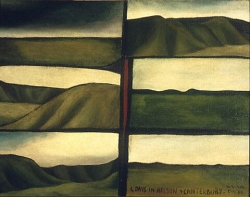
Artist Name: Colin McCahon Title of work: Six days in Nelson and Canterbury
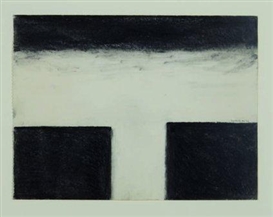
Necessary Protection
Notes on The Last Rivers Song and - DOCUMENTATION FROM TWO PERFORMANCES by LLOYD GODMAN AS A RESPONSE
TO THE COMPLETION
OF THE CLYDE DAM & THE FILLING
OF LAKE DUNSTAN - 1992-3
Prelude I
I
can't recollect, but I'm sure someone once said "change is the only
certainty". The values and attitudes of one society and generation give
way to those of another, and in the twentieth century western societies
this occurs with increasing succession. In the late 1970s through to
the early 1980s in New Zealand was a time when the environment was tested
in a manner that it had not been before, but it was a time when there
was also a response, an environmental awareness.
The early 1980s in New Zealand was a time
when many environmental issues predominated, it was a time when government
rhetoric proposed large scale development of natural resources as a
means of financial recovery and social security. While some strongly
favoured large scale development, others loudly condemned the rhetoric.
It was a time when social division prevailed and the community became
polarized over these issues.
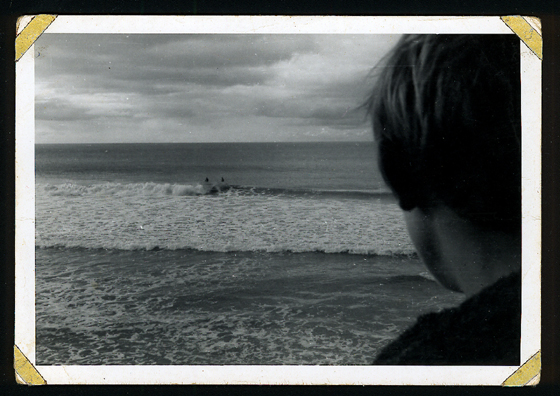
Graham Carse checking the tube at Aramoana. Circa. 1969 |
One of these "think big"
schemes was the proposed aluminum smelter to be built on the grassed
sand flats that converge with the expansive tidal estuary near Aramoana
at the entrance to Otago Harbour in Dunedin. The pro-smelter lobby argued
that the smelter would create jobs, bring growth and prosperity to the
ailing economy of an old stagnating city, while the anti-smelter group
argued that it would be detrimental and irreparably change the environment.
They suggested the effects of the smelter would damage a fragile
environment and associated wildlife, change the life style of
the residents and for these reasons must never proceed.
Aramoana was a place I felt
passionately about, a place that I had meaningful personal connection to, an emotional possession. For me it was a site where a part of "Eden fell"; where
we first cooked baked beans over an open fire, where we watched Carse
set fire to the lupines and the hot tongues of flame licked each strand
of the marram grass as we laughed with a stupid naivety. It was a place
where Dickie showed us the fundamentals of hanging the tail out on the
graveled corners in the trusty Morri 8, a place where we engaged in
our first beer-drinking weekends, although we spilt more than we ever
swallowed, and a place where we discovered something of the nature of
girls. |
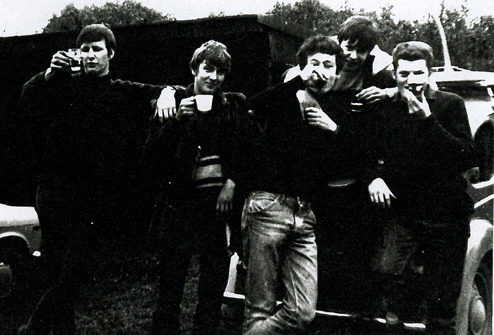
Circa. 1968 Aramoana, Dickies crib, Lloyd Godman second from left. |
Aramoana was a place I knew
well, a place where in the late 1960s I learnt to surf in a fun- filled
adolescence, a place where the chill of the south wind coaxed the sun-sparkled
swells with a whispering kiss into the hollow waves we searched for.
A place where the white plumes of spray feathered before shooting skyward
as the swells arched towards the fine white sands between us and the
shore, where a salt rain lashed us as each wave crashed in an ephemeral
crystal vortex. A place where the north east swells had a tempered power
perfect for learning on, unlike the large widow makers that crashed
onto the beach at St Clair and Blackhead. A place where the hot summer
sand barked under scuffing feet that hurried to be some place else,
a place where I first shared the ocean with the small blue penguins.
A place where the royal albatross skimmed miles across the ocean surface
on the flick of a single feather while we strained to paddle the short
distance through the waves to the line u. Aramoana was a special place. |
But long before this it was a place of different
memories, an older nostalgia. A place of family picnics, where the ocean
was cold and unfamiliar and swimming was only for a heated pool. A place
to kick balls, fish, a place of summer salads, cousins, uncles, aunts,
grand-parents, a place to talk and be
a kid in the January sun, a place to take the long climb and eventual
race down the great sand hill blown hard against the even greater cliff
face, as had my mother and her friends a generation before.
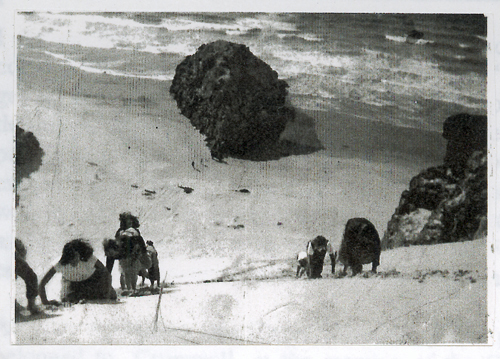
.Lloyd's mother with her sisters and friends
on a hockey club picnic climbing the great sand dune at Aramoana. (The
small dots at the base of the central rock by the ocean are people and
give some idea of the scale of the dune.)
Circa. 1946 |
At the hockey picnic, sitting on top of the great sand dune. Circa.
1946 |
Photographs are something
I have always been intrigued with. From as early as I can remember,
I was captivated by their ability to act as depositories of memory,
they allow us to recall with specific detail people, places and events
of our past. In this case, the photographs of my mother and friends,
they create a memory of an event not directly experienced by me. From early in my life, the combined narrative of my mother's memories and
the irregular discovery of the photographs in an album established a
powerful bond between myself and the place that augmented my own experience.
For as long as I could
remember, it was a place I belonged, I to it, and it to me. Before moving back to Dunedin, my life changed and in the intervening
period I moved away for several years, lived in the North Island and
Hawaii, experienced another life I could not have if I had remained. Soon after my return,
the smelter proposal surfaced, and it was an unwelcome intrusion to
my ideals of this place. Like many others, I was convinced that surely
an aluminum smelter would ruin the
essence of Aramoana, with insignificant
reward for the community and the country and I needed little convincing
the proposition must be protested.
It was! From the nation,
as well as the local community, there were out cries for the planning
and project to cease. Environmentalists, scientists, lawyers, recreational
users, families that had lived here for generations, and others that
had recently moved to the area, all protested, and among the voices,
none seemed more poignant than the artists. Prominent figures, like
Ralph Hotere, Andrew Drummond, Chris Cree-Brown, Chris Booth, to name
a few, made significant and powerful work that related to the issue,
they gained publicity and acclaim with exhibitions and appropriate comment
in various art magazines. Initially, because of the involvement of these
artists, I felt I had to be part of this cause too. After all, it was
a place I considered my patch. Around this time I was beginning to regard
my image-making as a more serious activity and part of my life, and
like the other artists, it seemed relevant to link the smelter issue
to my image-making.
Unfortunately, all too quickly
Aramoana seemed to become a fashion, a catch phrase, a band wagon to
climb aboard for the sake of protest, and from my perspective it reached
its peak when a report surfaced, that of a well-meaning North Island
photographer, camera at the ready, was found wandering aimlessly on
the sands of Victory Beach, on the opposite side of the harbour, convinced
he was at the threatened location and making an important series of
documentary images.
While I still felt strongly
about the smelter, and the concern drove a need to comment on the proposal,
I was also concerned about the ineptness of working on a project that
appeared to have adequate comment, a project everyone one and their
dog wanted a piece of. I debated the issues over many months until it
became obvious the planning for this smelter could only proceed under
the rhetoric of the `THINK BIG' schemes promoted by the government.
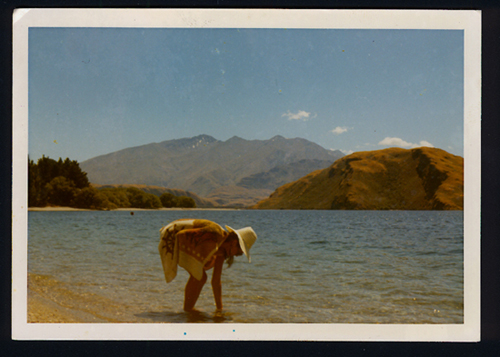
Rose Kennedy a first love of Lloyd's at Lake Wanaka at the head of the Clutha River - Circa.1969 |
The viability of the smelter proposal was associated with and was indeed
dependent upon another "Think Big " project, the cheap `surplus power'
produced from the proposed Clyde Dam output; an equally dubious project.
Here was another important environmental issue, for the high dam proposal
once completed would destroy a exceptional wild stretch of river and
much of the unique surrounding area. For me it was an equally important
environmental injustice, another saga of `Environmental vandalism'. As with Aramoana, the Clutha river was also
a place of family nostalgia, a place I belonged to.
As with Aramoana, the Clutha
river was also a place of family nostalgia, a place I had emotional possession and one I belonged to, Cromwell, at the meeting of the Clutha and Kawarau rivers was a place
where as a family we had holidayed for many summers, a place where I
had swum with my brothers and sister, friends and relations in the calmer
stretches around Lowburn, where the water quietly curled around the
warm lumps of sand that locals called Sandy King's Islands, as it ran
sea-ward from Lake Wanaka, licking under the lazy hanging branches of
the willow trees. |
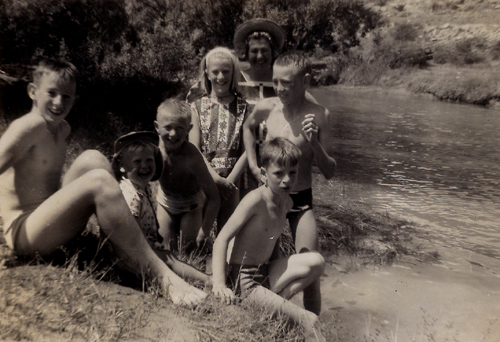
At Sandy King's Island, near Lowburn, Lloyd standing on right, his mother
behind Circa.1964 |
It was a place where I had hunted tadpoles
as if they were strange magical creatures that might possess the answers
of life, fished for eels in black waters and flickering fire-light,
slept under the clear inland skies and wondered how large really was
the universe.
It was a place where we
had played a full 9 holes of golf with cricket bats. it as a place where
I had already conducted my own dam experiments, a place here, with my
cousin we had flooded a whole orchard as we experimented with the controls
of an irrigation dam, it was a place where we had also gorged ourselves
on tree-ripe apricots as we picked box full's in recompense. The orchardist had instructed us only to pick the firm fruit that was not yet ripe - the ripe fruit we were allowed to eat. It seemed strange at the time that the best tasting fruit was discarded, and this led to my interest in growing my own fruit that I could let ripen on the tree. First in the garden at Brighton, Dunedin, and then in St Andrews, Victoria. |
It was a place where on
more than one occasion the strong winds and heavy rain had leveled our
tent, a place where in the warm breeze and darkness of a summer's night
I had kissed a first love as the river below eternally washed the rocks
as it ran forever onward to the ocean. And over the summers it was a
place I had always spent hours entranced, watching the water spin and
curl in the blue magic, its depths and white rapids, it was a place
where I had witnessed the evidence of hard rocks torn away by the softness of water,
it was a place where the surge of water pushed a land locked surf, a
place where the river pounded off down the gorge sucking every drop
of water from the black tarns high in the mountains, from the melting
winter snows above.
But from
my very first visit to this environment, I also sensed that here in these
canyons was something of a primeval New Zealand: a quintessence that
only the initiated could perceive, a darker mysterious side to the landscape
that opposed the popular image of yellow poplar trees, blue water, the
delicate cultivation of the orchards, the cheerful escape of a summer vacation. It was a distinct quality that Van Der Velden, McCahon,Baxter,
Hotere had
already perceived, a blinding light against a primeval blackness.
The construction
of the dam seemed to be the crux of the predicament, if there was no
dam there would be no smelter, the two issues were inextricably spliced and
a statement about the dam was
a statement about the smelter. There was much less protest from artists
about the dam, the focus for many had been the smelter, and those artists
that did make comment on the river were perceived as less "vogue"; the
dam issue was not the "bandwagon" the smelter was. So, not only for
its importance as a significant place but because of this unacknowledgement
by the art establishment in 1983 I decided to work with
the Clutha River and not Aramoana.
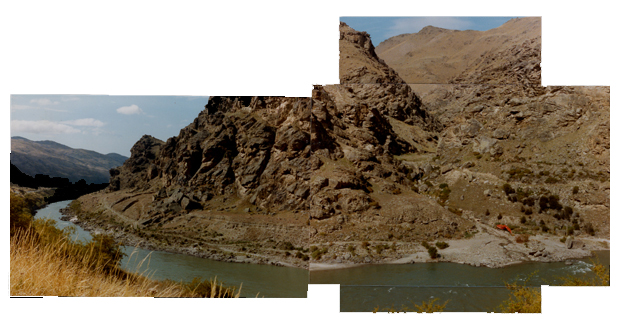
Cairnmuir face and the Clutha River 1984
notice the fruit growers road on the opposite bank of the river. This was eventually flooded when the dam was filled.
On the lower left is a digger undertaking some work for the construction of the dam.
|
From the
outset, I realized that while the smelter protest was much more likely
to succeed, the government was already committed to the dam, if for
no other reason than the fact that political futures were at stake,
and the project was unlikely to be terminated. I was not put off by
the not being able to halt the project, indeed it insinuated a poignancy
in working on a project centred on a place that would be affected, would
be changed forever. Other artists had also worked with the dam issue,
Robin Morrison, a sensitive series of portraits on the residents effected
by the flooding; Marilynn Webb a compelling series of prints called
"Good Bye- Clutha Blue" in 1983 and Bruce Foster a series of cibachrome
prints investigating the pre-construction lines painted on the land,
it seemed none had dealt with the elements that I found compelling,
the essence of the river, the contrasts of rocks and the water,
of solid and fluid, of blackness and whiteness and the spiritual analogy of light against the void.
Eventually,
the protest against the smelter at Aramoana was successful, the proposal
became less an less viable and eventually disintegrated, leaving the
environment intact. However, the dam proposal was one project that despite
logic, cost over-runs, earthquake fault lines under the foundation,
re-roading problems, threatened subsidence on the banks, was pushed
and pushed to completion. |
Initially I researched the area to be affected and from the relevant
information, mapped out the boundaries my project should investigate,
discovered the creeks, streams, the rocks, bluffs, sweeping currents,
swirling eddies that would disappear under the proposed lake. I looked
closer, discovered the names of these features, discovered Byford creek,
Hydes Spur, Sonora Creek, Leaning Rock Creek discovered
Cairnmuir Gully, Gibraltar Rock, Nine Mile Creek, Jackson Creek, Firewood Creek, Deadman's
Point Walker's Creek Banockburn and Molyneux Face, discovered names
to places that I would soon become much more familiar with. But quite
soon, I also discovered there was more at stake than just the flooding
of the "Clutha River", for quite a stretch of the Kawarau branch that
converges at Cromwell and runs down from Queenstown and lake Wakitipu
would be stilled by the dam too, the filling lake was to push up the
reaches two rivers, still the native waters of two rivers, and the loss
of both these areas motivated me to complete this project.
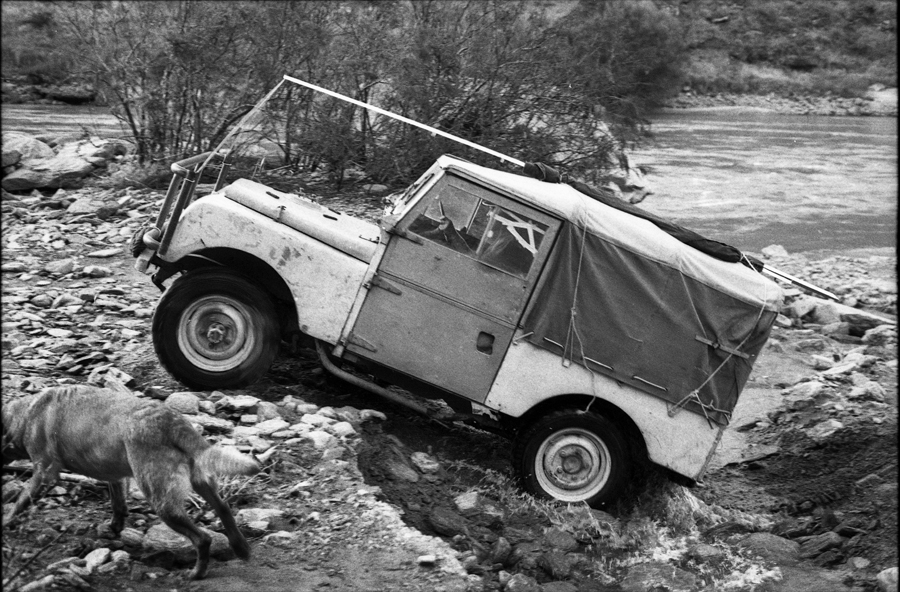
Lloyd's 1953 Land Rover crossing a washed out ford on the fruit growers road - the boom used to place the camera for the water shots is tied to the roof. |
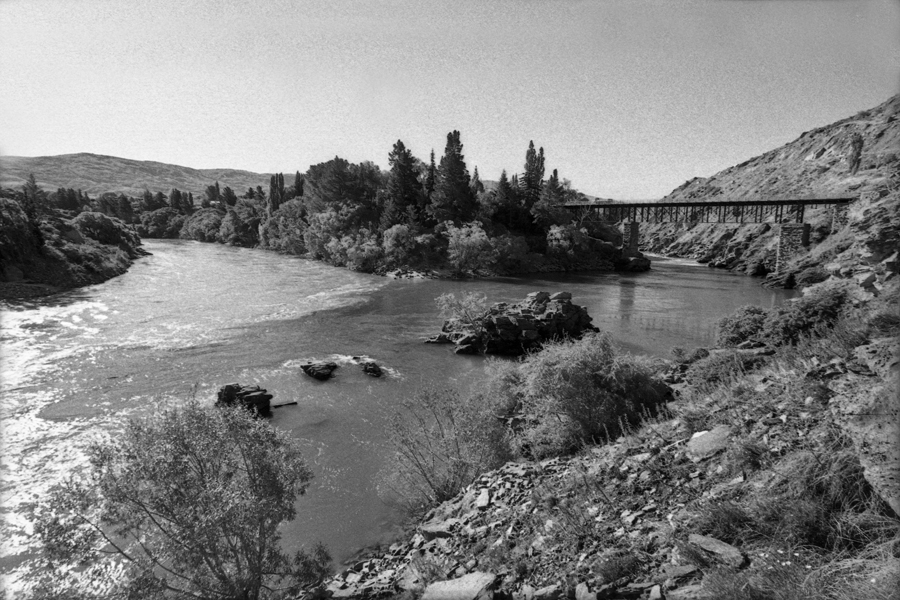
The meeting of the waters below the old Cromwell Bridge - once Lake Dunstan was filled the bridge was submerged |
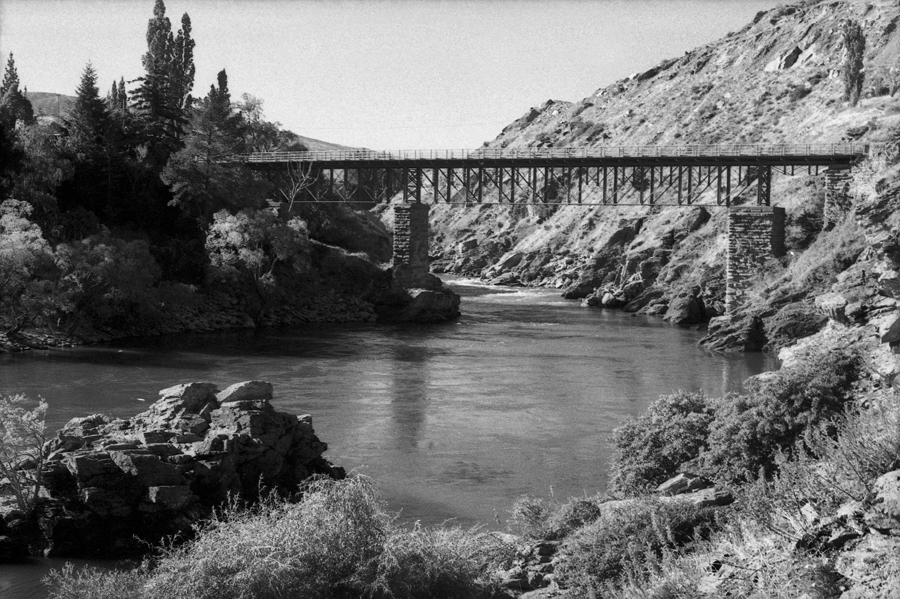
Detail - The meeting of the waters below the old Cromwell Bridge - once Lake Dunstan was filled the bridge was submerged |
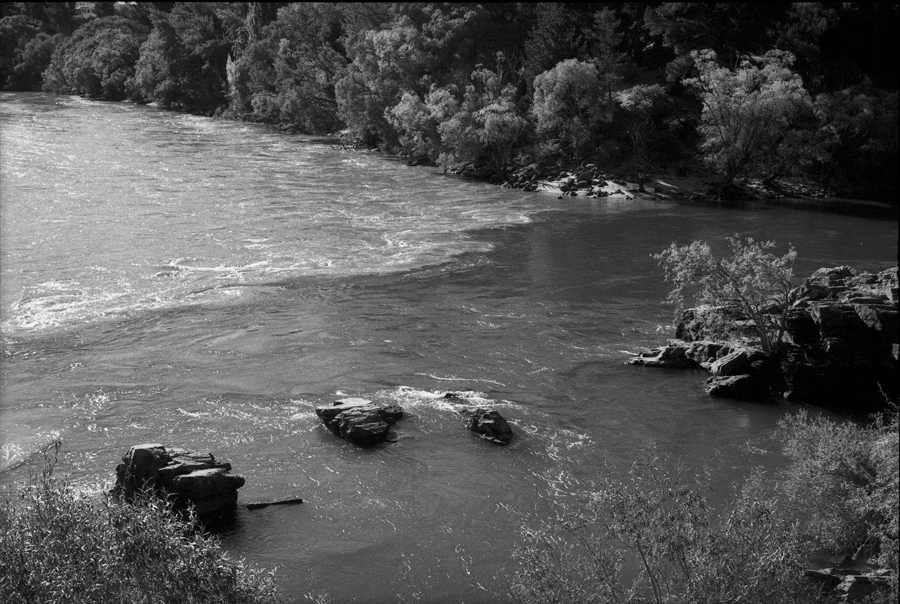
Detail - The meeting of the waters Clutha and Kawarau Rivers below the old Cromwell Bridge - once Lake Dunstan was filled this was destroyed |
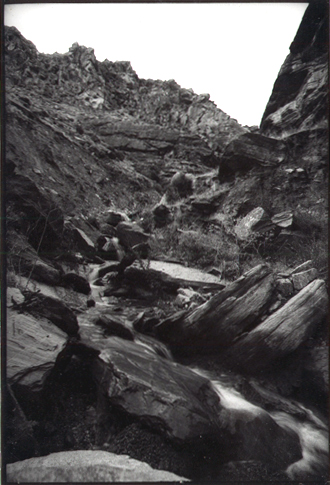
Cairnmuir Gully from Clutha Panel IX |
During 1983-4 I made several
expeditions to the area, photographing extensively along the winding
curves of the river that would soon be flooded. I camped with Elaine,
then pregnant with Stefan, our first son, in the immense eerie valleys
and canyons like Cairnmuir Gully that
run up from the river near the fruit grower's road across the river
from the main gorge road so I could photograph the last and first light
on the river, I spent winter days with a river in full flood as the
sleet turned colder to snow and spun shrapnel-like from the sky, I climbed
and crawled over the raw boulder-strewn banks of both sides of the rivers,
I witnessed the sheer chasms cut in the rock over thousands of years,
the huge boulders tossed down the gorge like broken marbles, and I left
only foot marks in the thick silt piled on the bank after a flood, while
all the time taking photographs.
During these expeditions I shot roll after roll of
film, always investigating the essential elements of the river |
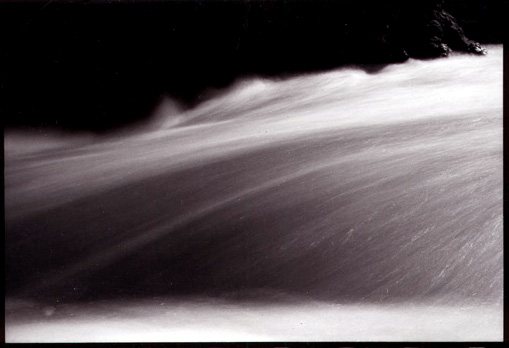
the reflective qualities of the rushing water - |
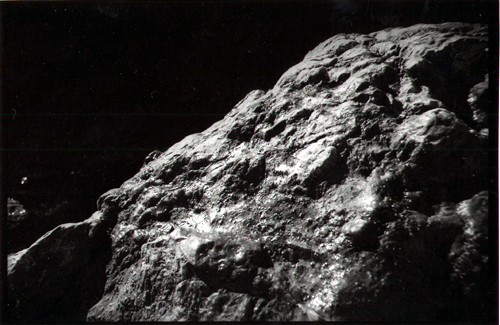
the hardness and darkness of the rocks - |
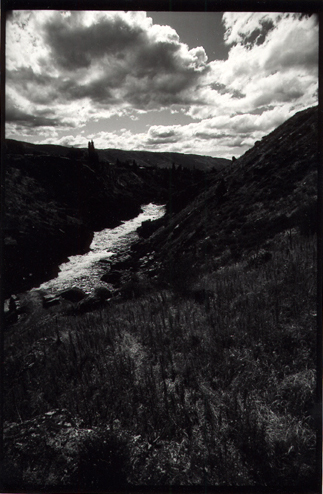
the black and the white. |
For me the true essence
of this river was the relentless force of the water,
the unification of rain drops,
melting snow flakes and ice into a potent force, seeping slowly from
the frozen heights into ever growing trickles, babbling brooks, tumbling
steams, racing creeks, small rivers channeled by the hardness of the
bare rocks into the third fastest flowing river in the world.
The work from this period
was duly completed, exhibited during 1984 as a large series of mural
photographs up to 20' long and a smaller series of photographs,
mounted in sequences that became known as the "Clutha Panels". Later
the work was published in 1989 in a book (Last Rivers Song) with an
introduction by Brian Turner, who was also instrumental in publishing
the work. Despite this and the fact that the dam construction, problematic
as it was, continued in one form or another, I never expected the flooding
to happen, for so many years it appeared so distant.
The Last River's Song -
a poem from 1984 - Poetry
Gone ! the swirling vortexes,
the fly
of spray, the suck and the spit!
Gone! the rapids' roar, the ever-
changing eddies and the crash of foam!
Gone ! the gentle lap of a river
at her
bank and the violence of her flood!
Gone! A River's Song!' |

The Clyde Dam with Lake Dunstan |
Depending whether one was
a procrastinator, engineer, government official, politician, local,
protester or contractor, the completion of the dam and filling of the
lake became both dream and nightmare. Problems seemed to ooze from the
very rock itself, a dyke-like structure with eleven leaks and an insatiable budget.
But finally, after delay
after delay the set time had come, the dam was complete and ready to fill. For some time it
stood awaiting commission like a grotesque great Egyptian pyramid, a
technological wonder waiting for a purpose, waiting for the pharaoh
to die. The was main highway was stabilized, enough drainage tunnels
drilled and hill sides removed or secured enough not to tumble down
into the lake, and the river would change forever, would sing its last
song. I was quite dismayed when a date was set and the flooding
would finally begin. As with the earlier series of photographs, I felt
I had to respond to the irrevocable act, the death of the river's song. I felt
I had to mark the passing in some way, but if I did it would have to
be in a much different manner than the earlier work that celebrated
the rocks and water, a response would demand another quite different
strategy. |
DEATH OF A RIVER - Lake Fill
Series
Ultimately, I had decided on a performance-based
work, a ritualistic ceremony at the very time the water was rising, the old river
dying and the new lake growing. I imagined a ceremony that marked the passing
of the river's flow, a performance that not only used photography to
document the event, but incorporated it as an integral part of the work,
where by the end, a camera would have recorded a vista of the river sequentially
obliterated by the rising water. From 1988, the integration of the photographic act had already become an aspect of my work through the Summer Solstice works. At this time I had also come to realize
much about how the politics of the "Art World" in New Zealand worked and
had decided I preferred to work in a private capacity with the performance. But with assistance these would be well documented.
INITIAL CONCEPT
When I first arrived at
the river \ lake site to carry out the performance work, I had intended
to work from the premise of the lake filling with water as the authorities
had stated in a newspaper item a few days before and I had confirmed
during my telephone conversation with Electricorp officials to gain
clearance to work on the lake shore. During this period, they had calculated
the lake level was to be rising at 2m a day, which I had estimated would
allow me to lie prone at the water's edge for about 3hrs, mentally absorbing
my body into the soil, becoming part of the earth, but at the same time gradually
becoming drowned as the land around me submerged with the rising water
level.
As it turned out, on the
day I had traveled up to the site to complete the performance, coincidentally,
Electricorp were testing the diversion gates and the lake levels were
fluctuating wildly both up and down. This created a problem with the
concept of my original hypothesis and I had to quickly adapt and reconceptualize
the work to suit the situation and the environment I now found myself
in. However, I felt by the end of the work, this modified concept brought
stronger aspects to the work, brought a degree of sophistication, brought
more of a challenge both to me and the viewer than the earlier idea.
It related to the sense of place and the event with a range of iconic,
symbolic and indexical references.
While the rhetoric of image-making
might assume an intention, and audience, these presumptions can be undermined
or at least minimized. The intentions of this work are somewhat explained
in the text, but the audience of the performance would be exclusive
and include only a few friends who were willing to document the event
with both video and still cameras.
The work involved a private
performance acted out in a ritualistic manner with two friends, Ludmilla Sakowski and Eng Teong Low and
a television crew to document the work.
The physical movements were slow, methodical and mostly intentional.
Initially, a variety of construction tools and materials needed for
the work were laid out neatly on the coldness of the bare earth near
the selected site. Some distance away, and out of sight from the viewers
I changed into the insulated security of the black dry suit which had
now became the `ritualistic costume'.
At this point the work proper
started, and in this black costume I became a strange silhouette, seemingly
out of context with the yellow dry autumn earth of Central Otago, I
walked slowly, robot like, toward the chosen site.
Emerging from the infinite space of the land I directed my presence
to the selected area for the work, becoming visually larger to those
few watching with my every step. Once the imagined performance precinct was reached
I selected from the tools, equipment and materials arranged on the ground,
several pieces of pre-cut white cardboard. |
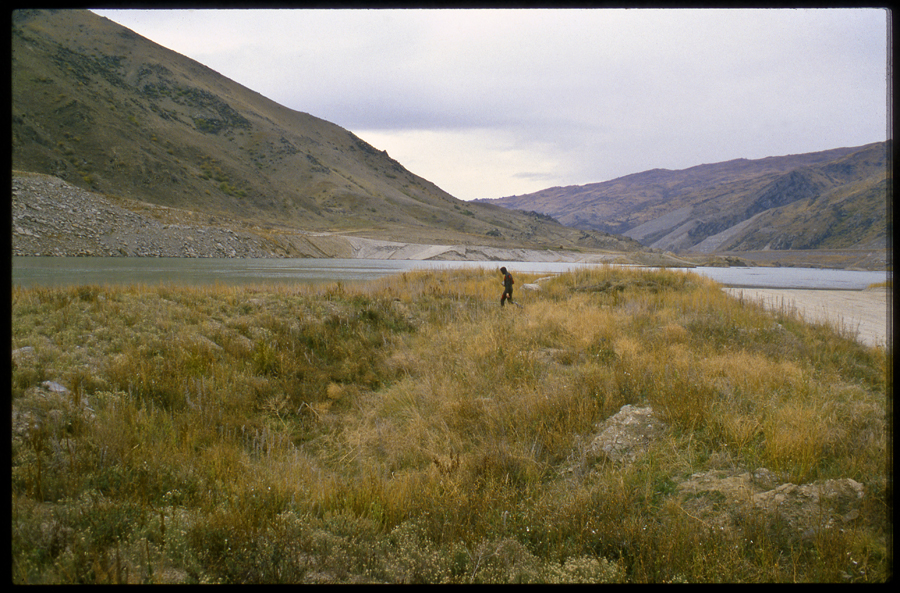 |
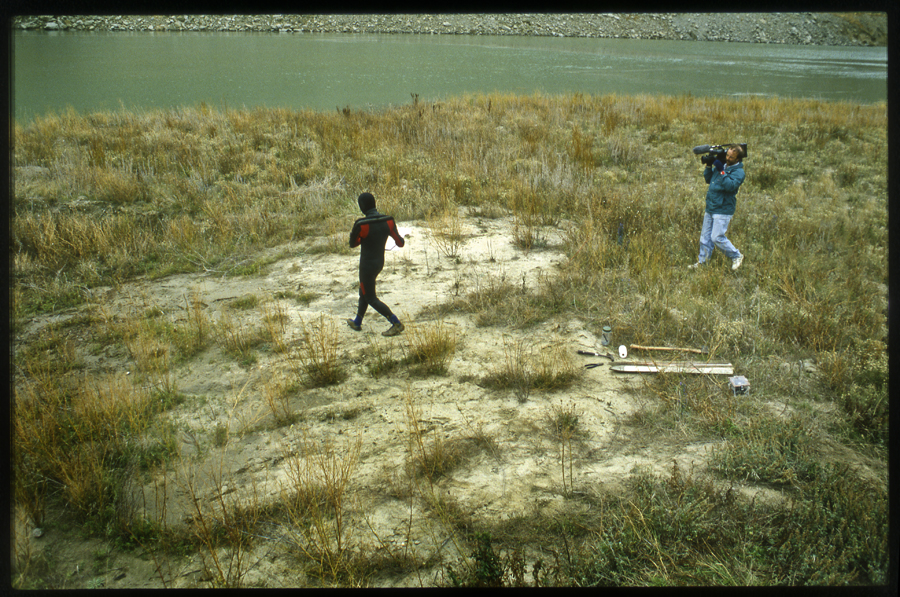 |
In deliberate motions these were
taken to a pre-selected area of bare of ground near the rising water
level and the parts were laid out to construct the positive white shape
of a human figure with both arms outstretched to form a cruciform. |
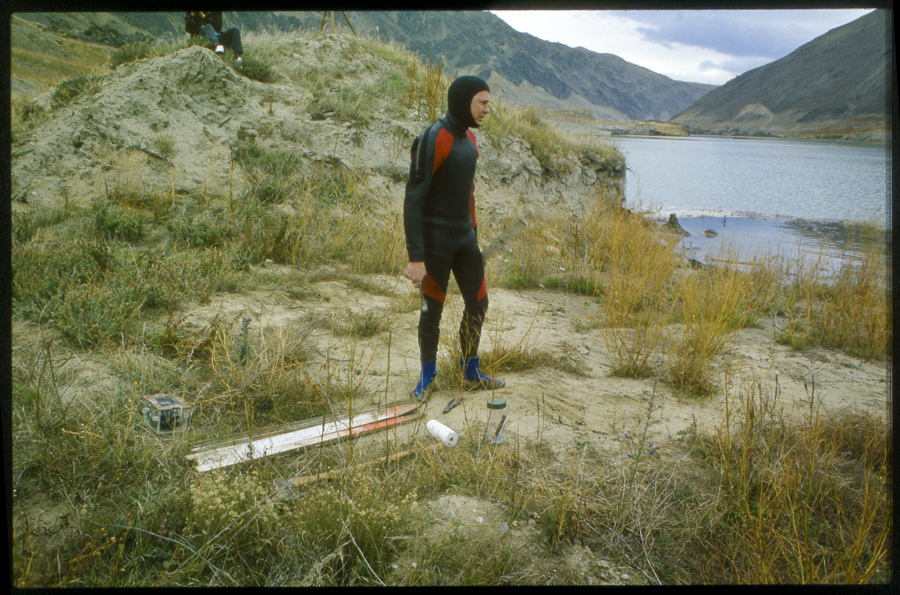 |
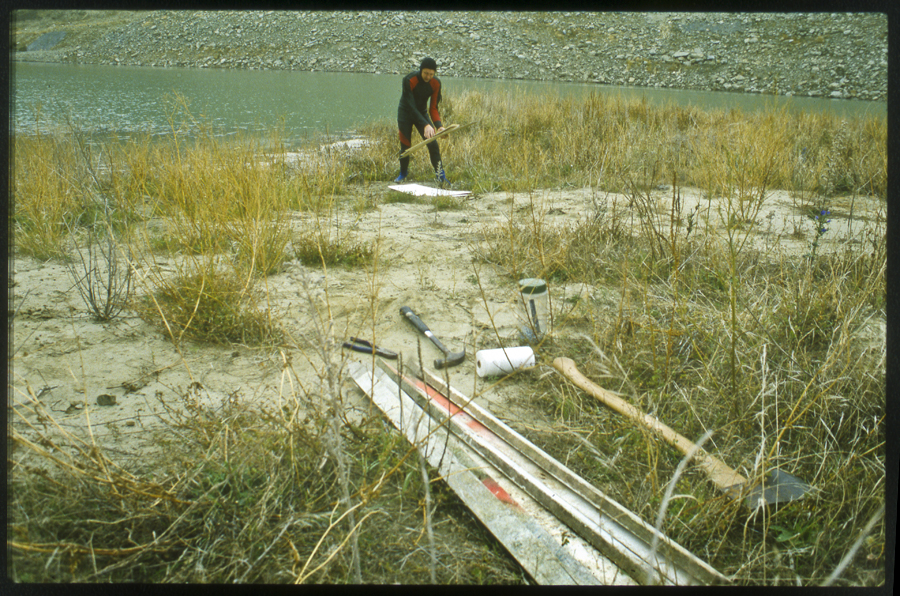 |
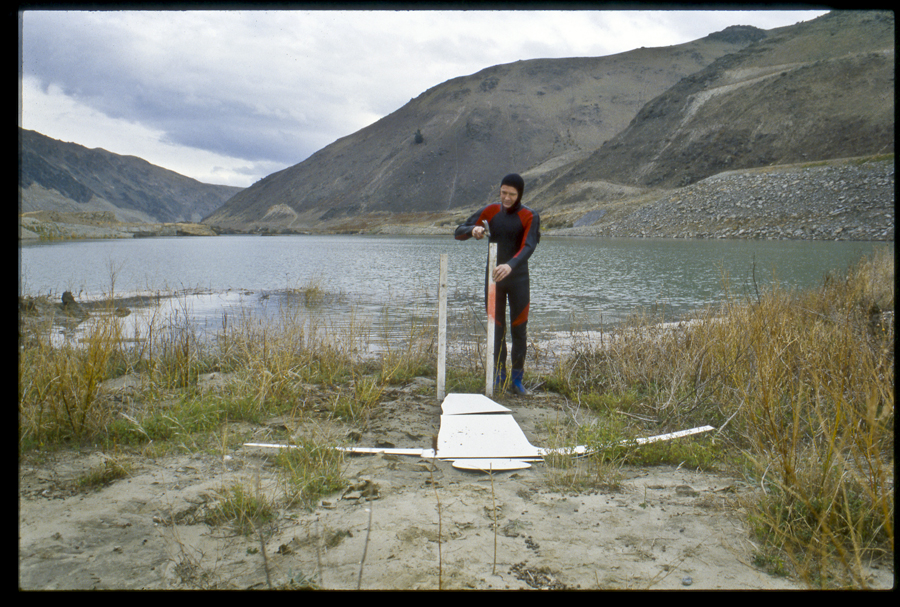 |
This
formed a white shadow of the raw earth itself. Next, a discarded surveying
stake was picked from the assortment of materials previously laid out,
and hammer driven with the same ritualistic mannerisms. With an almost
robot-like style the stake was driven into the ground at the feet of
the bright white cut-out figure on the earth. |
Five more times, a stake
was selected from the pile and was calculatedly driven into the earth,
until there were in all six stakes forming the unmistakable shape of
a crucifix surrounding the white card figure. Two were at both the head
and the feet, while another two denoted the ends of the traverse that
were the extended arms. |
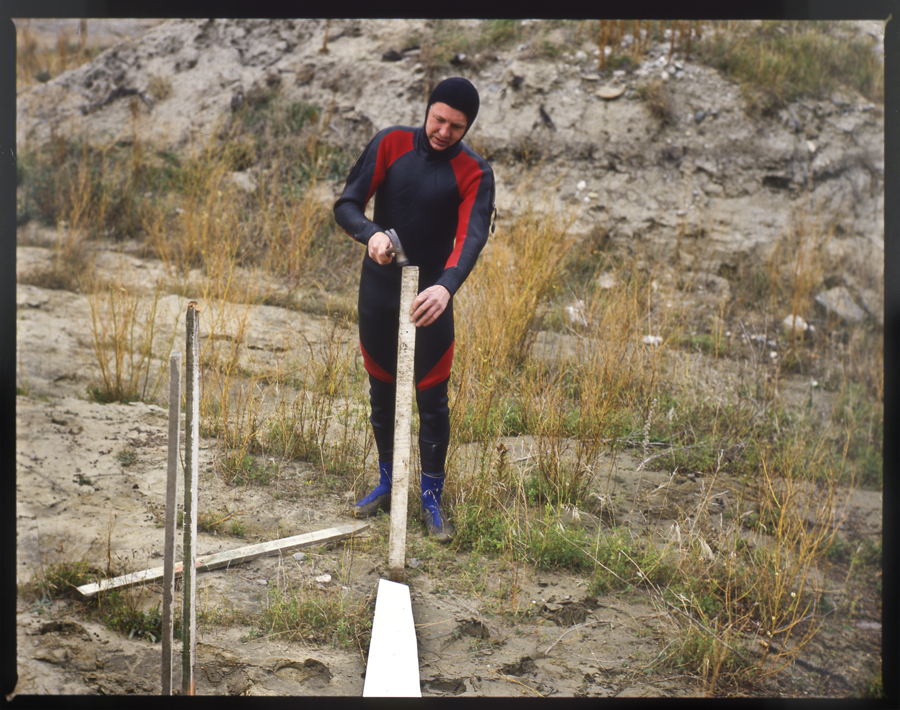 |
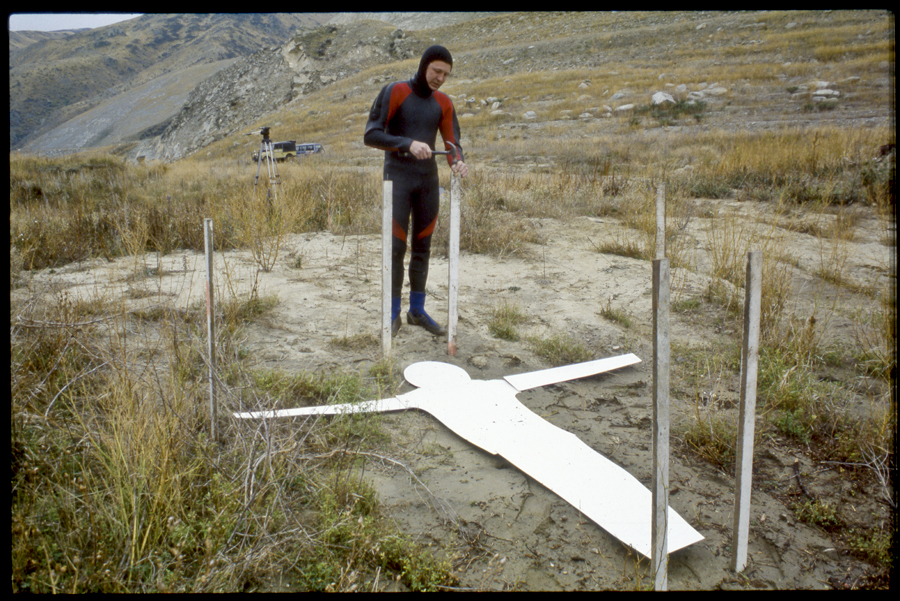 |
Again, systematically, a
small nail was driven into the top of each erect post, and between the
stakes I strung the taut lines of a fine white charting thread that
clearly defined in another space the plan of the wooden skewers that
confined the body shape on the naked earth below. |
| (Firstly the earth
is ominously dissected by the imaginary lines of the surveyor, the thin
line on the plan; severed and gashed by the ingenuous mark in the intangibility
of imaginary space.) Next I elected
to use a thick felt pen from the array of materials and tools at my
disposal and on the upright posts I rewrote the sun-faded word
"FILL" that already existed from a previous life, a previous surveying. |
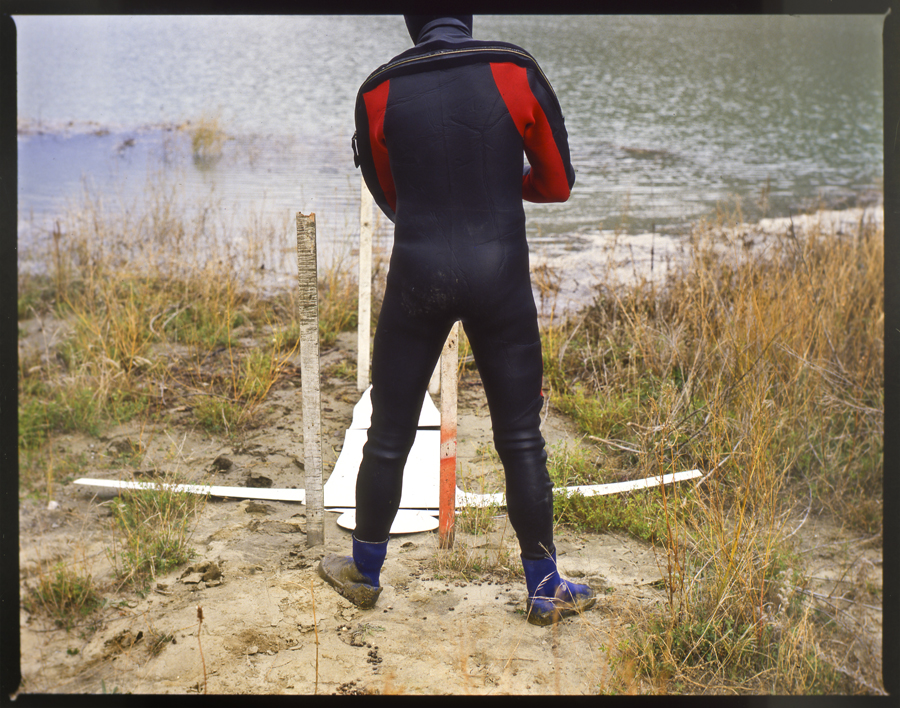 |
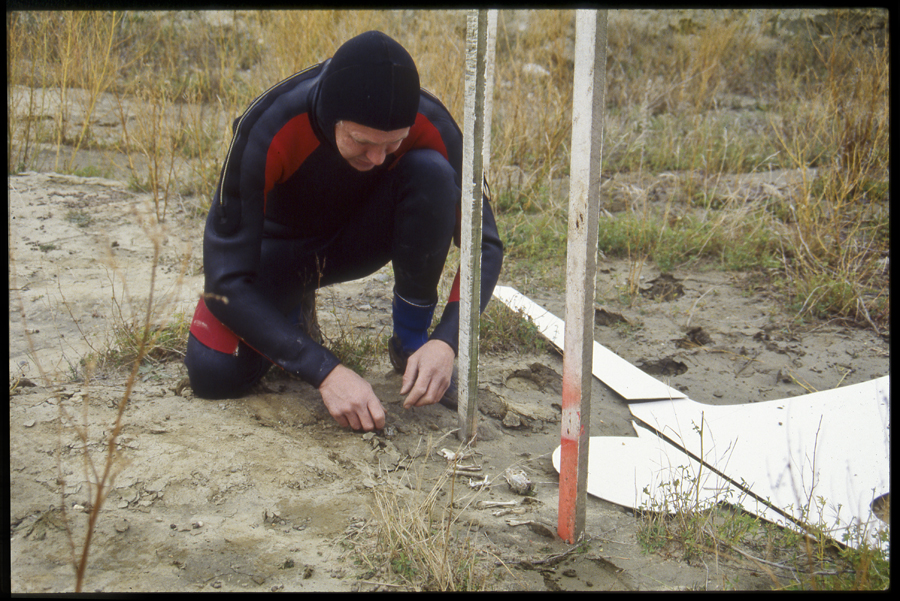 |
By fate, there in the broken
autumn grasses, in proximity to the performance site, lay the bleached
bones of a dead animal, a rabbit. A poor creature removed against its
own will to a foreign land in a thoughtless act, and now, because of
a saturated population and the effects
of the associated erosion, its kind are despised and exterminated as
a pest to this unfamiliar environment. The rabbit was a national symbol
of an earlier environmental miscalculation! |
| As a homage and with
utmost providence, these few humble dry bones were gathered from their
secret position and arranged with prominence, on the hard river silt
at a place above the head of the alien white figure; with the rotting
skull as a centre piece of the arrangement. |
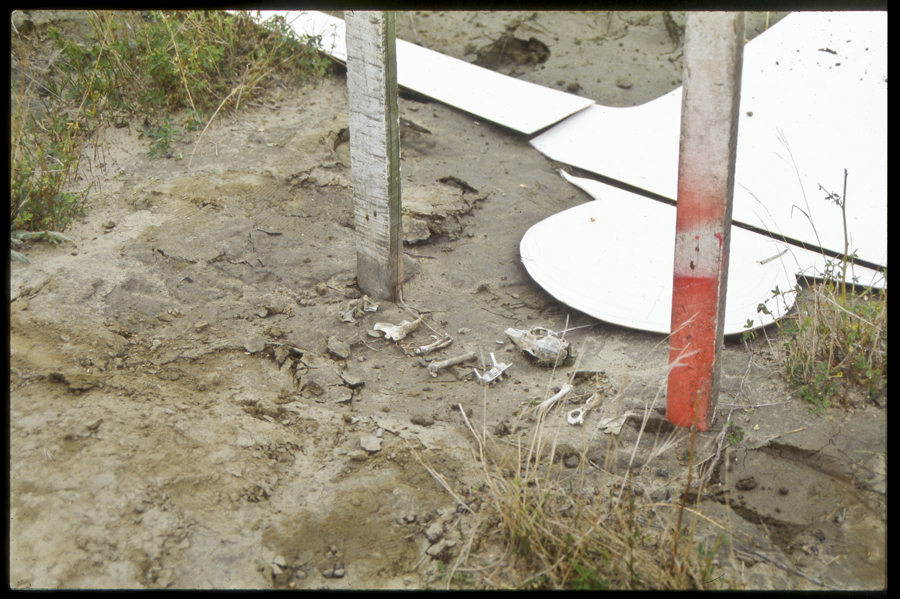 |
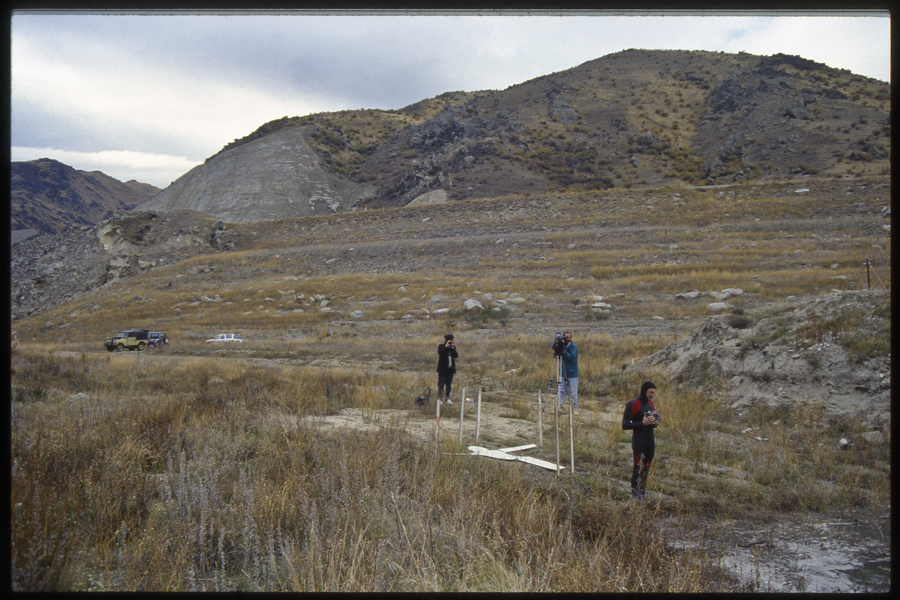 |
Then, with this simple but
metaphorical installation complete, I gradually moved towards the water's
edge, with a camera surrounded by the insulation protection of an underwater
perspex housing, firmly gripped by both hands against my chest. |
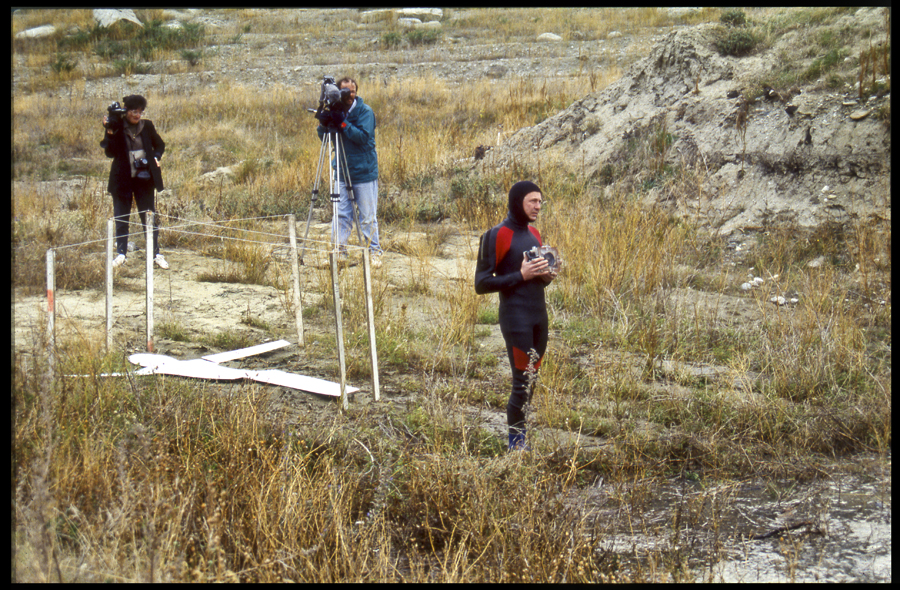 |
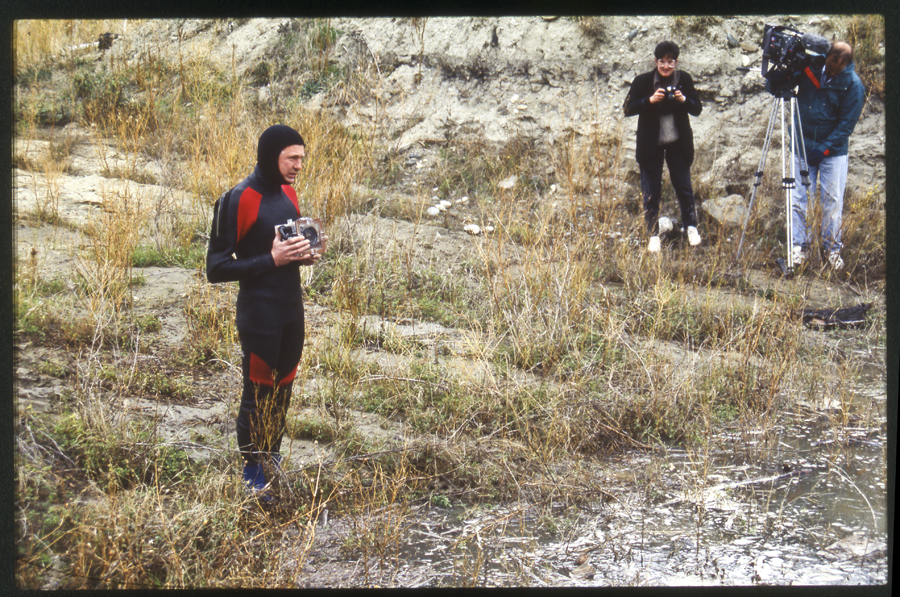 |
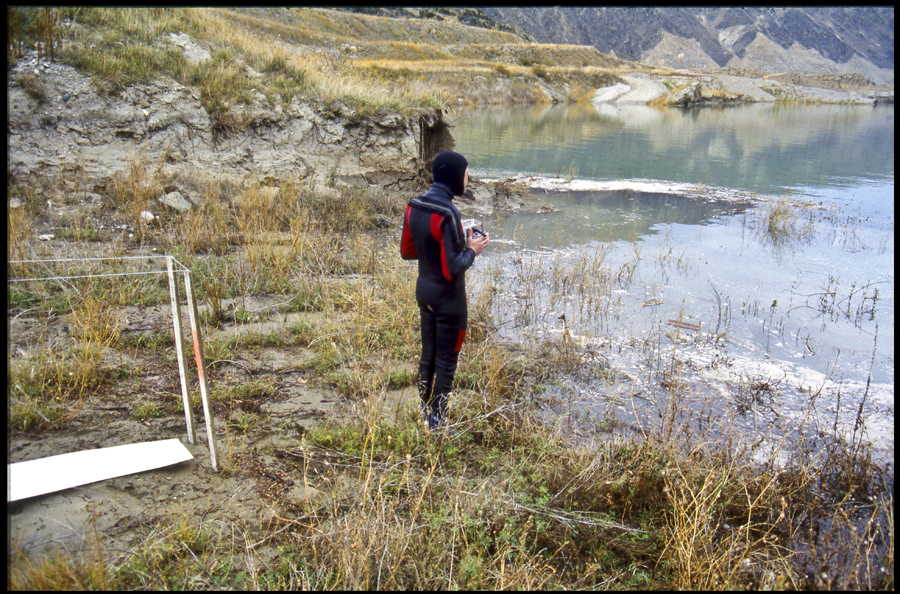 |
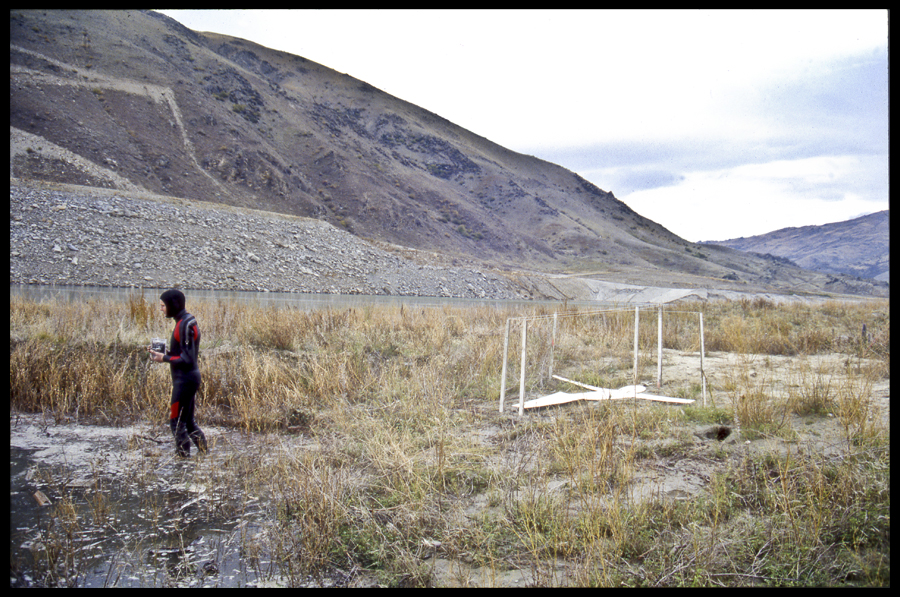
|
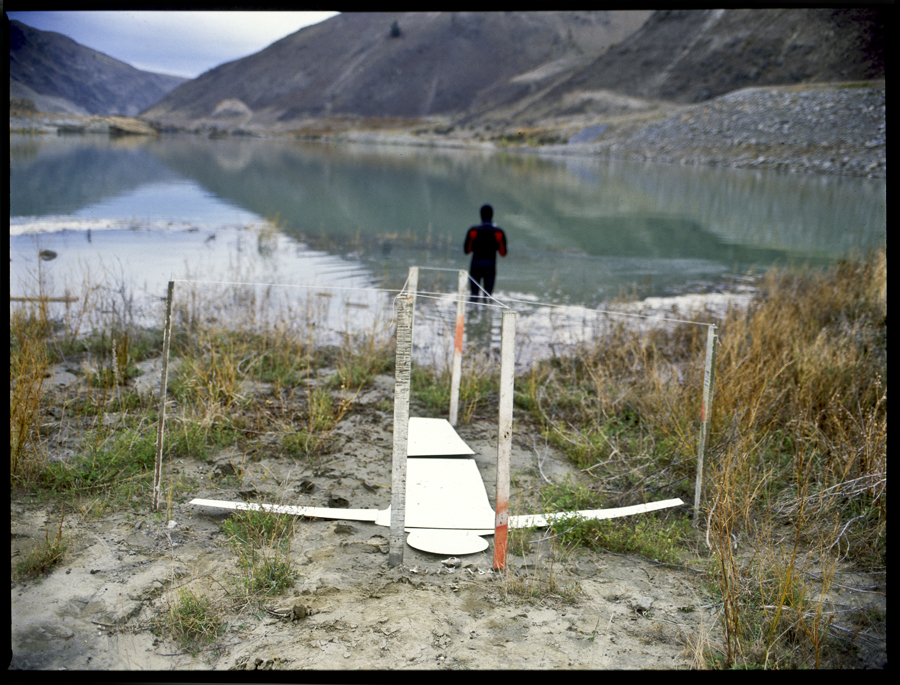 |
This
instrument was used as it should be, in the ritual of image-making,
to take photographs from the work site, across the ever-rising lake.
These would be records of a sublime or ridiculous and unique event.
Over a period of perhaps 20 minutes, I slowly moved through the new
and surprisingly sticky mud of the shallows out into the deeper waters
of the filling reservoir. As I proceeded into these cold uncertain depths,
a series of photographs was taken until the camera lens disappeared
completely under the surface of this juvenile and virgin lake. At this
point, I was well free from the secure touch of the old land that had
only hours ago surrendered to become the new lake floor, and there I
drifted, betrayed by this false vestal of tranquil water, controlled
by powers beyond itself. |
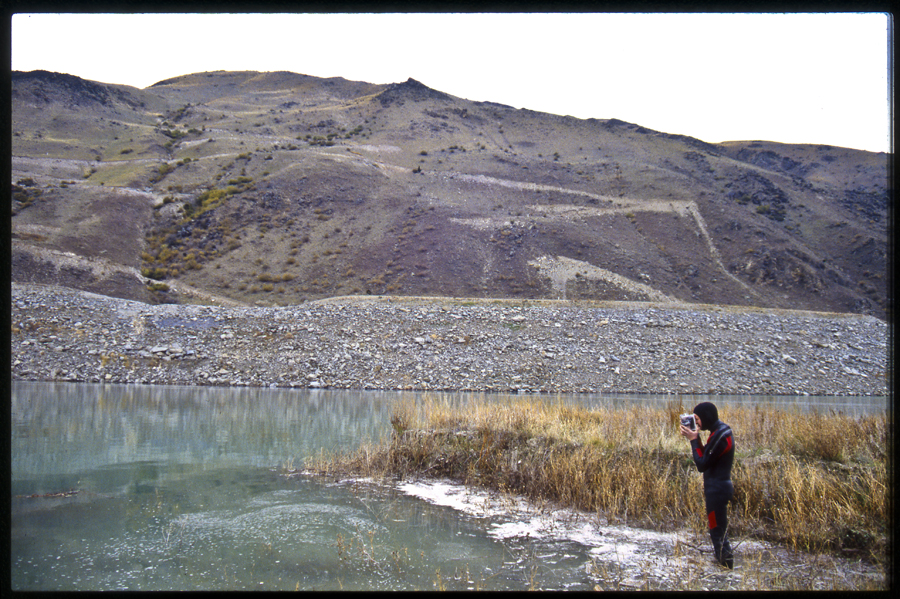 |
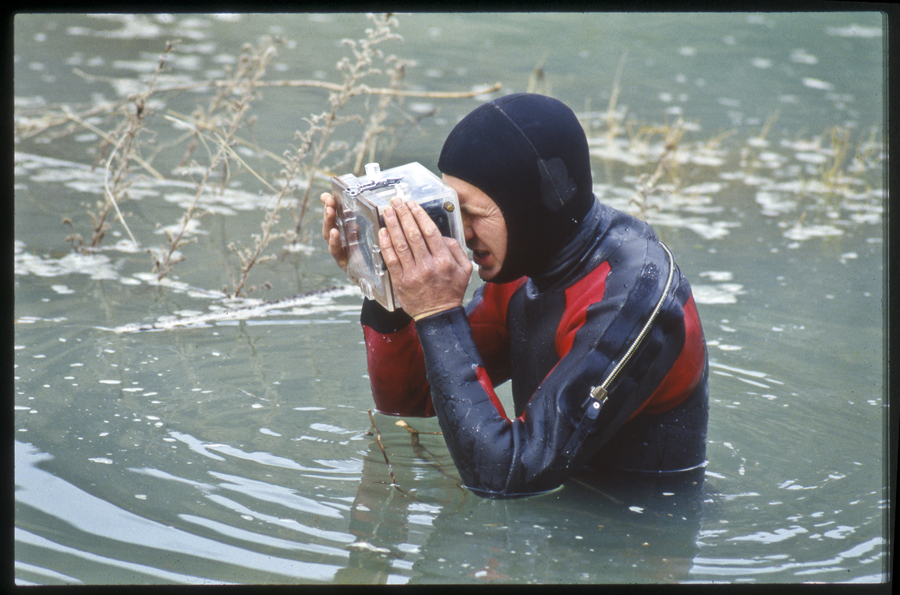 |
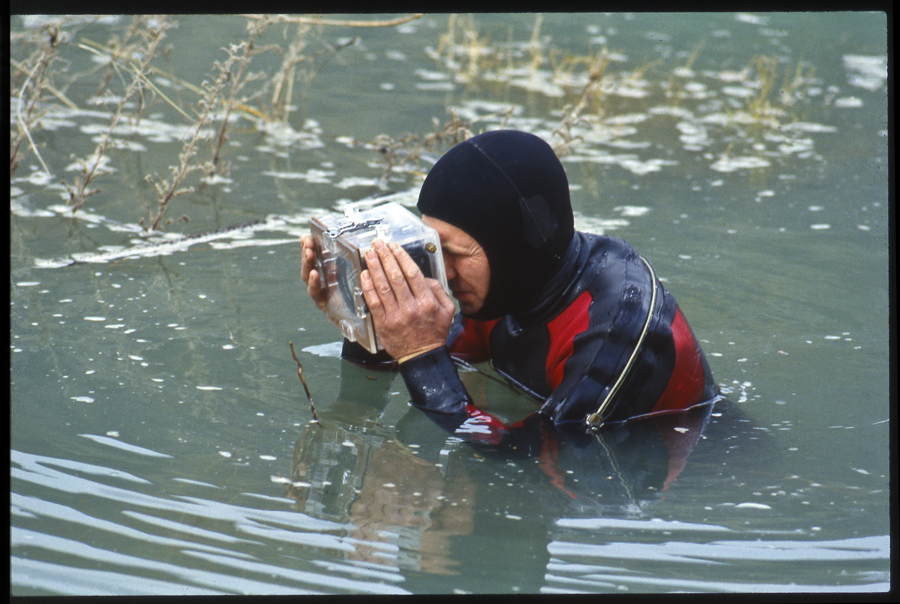 |
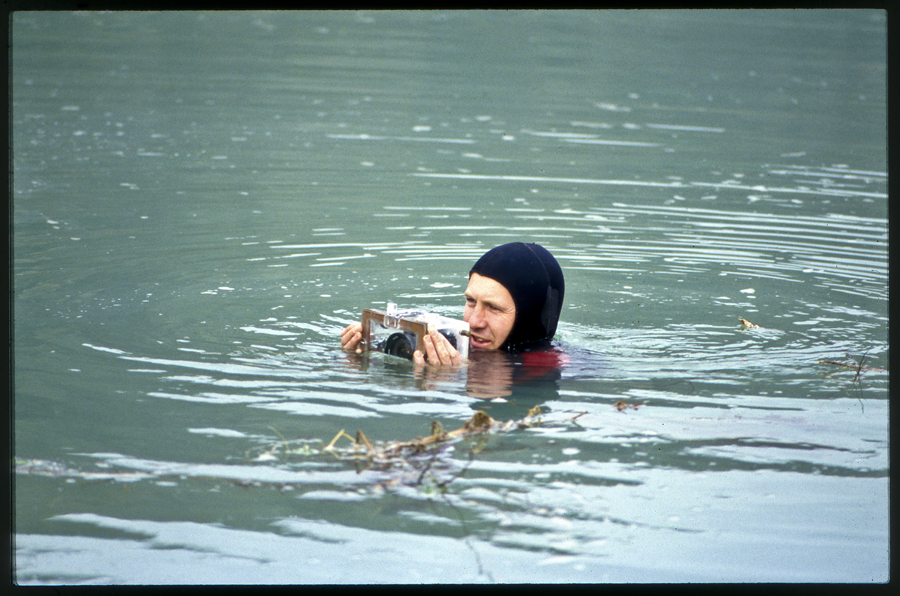 |
 |
|
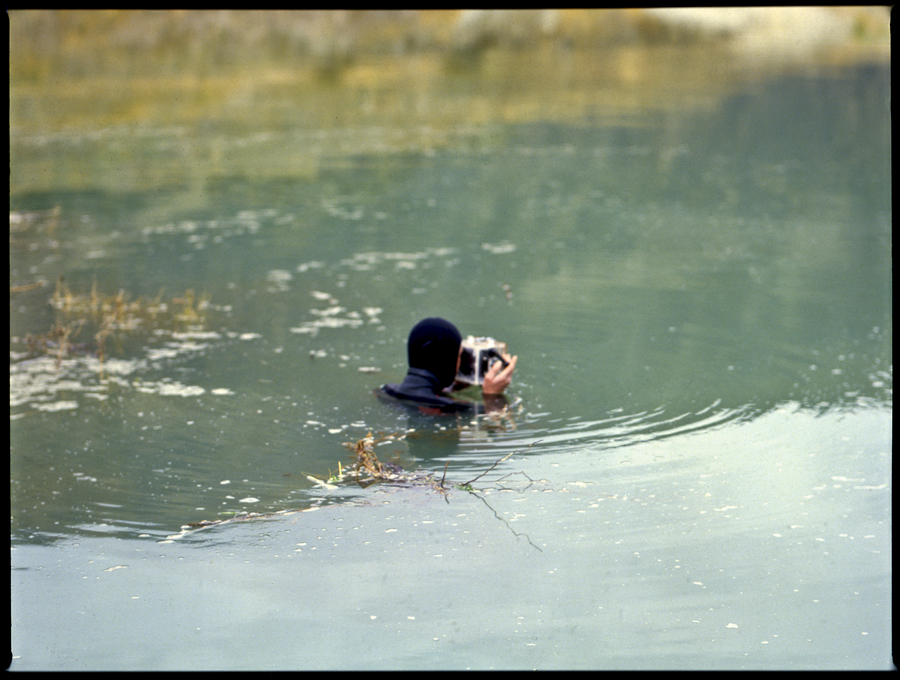 |
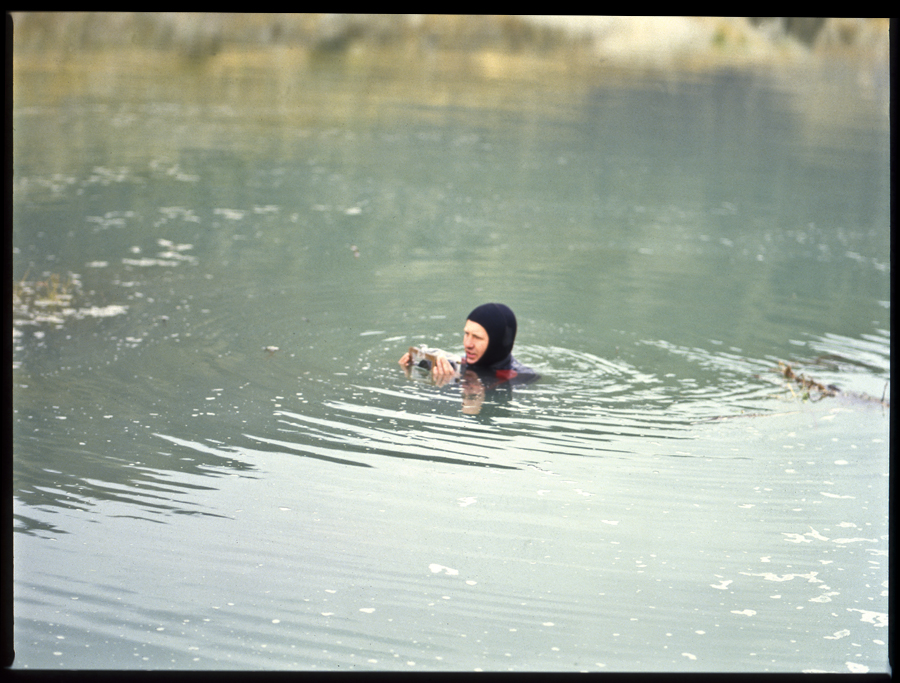 |
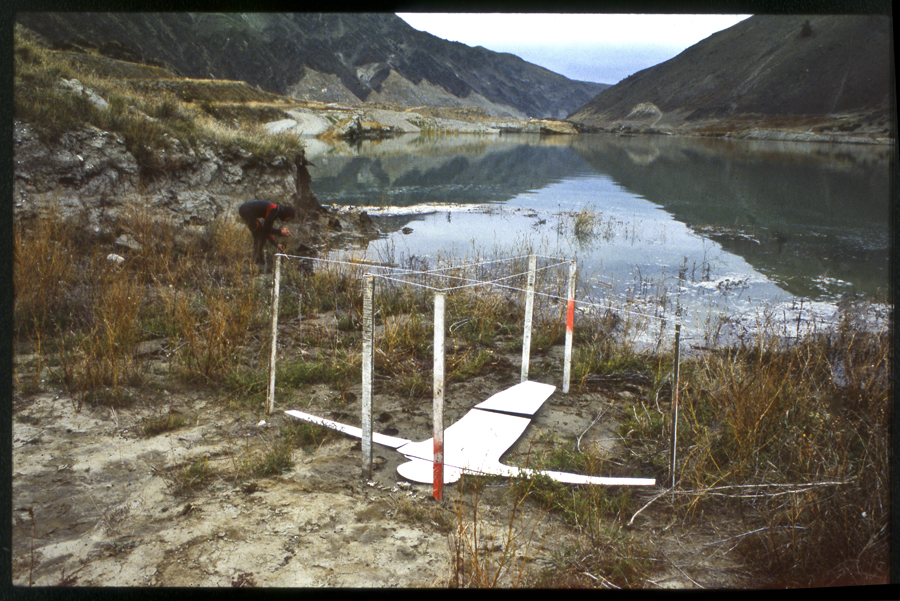 |
After an uncertain time,
I turned and made a prosaic return to the shore where the white card
figure installation still waited, encircled by the surveying stakes.
Upon my return to dry earth I found a stick, floated off with the rising
water, and now lapping with a bulk
of debris and foam at the water's edge. Using a native rock as an unsophisticated
tool, I drove it into the silt at the very edge of the washing waters. |
| Having marked this present level, I was compelled to walk over to the
cut-out figure and with due ceremony, walked from the feet, up the body
of this curious configuration and then took one step out onto each arm
in turn. At this point my body sank down and collapsed prone, on top
of the now silt-soiled whiteness of the cut-out form. There I lay, prostrate,
an out-stretched black negative shape, identical, on the larger and
positive card cut-out below, the tonal contrast resonating on the terra
firma that would soon become engulfed in a watery tide created by technology. |
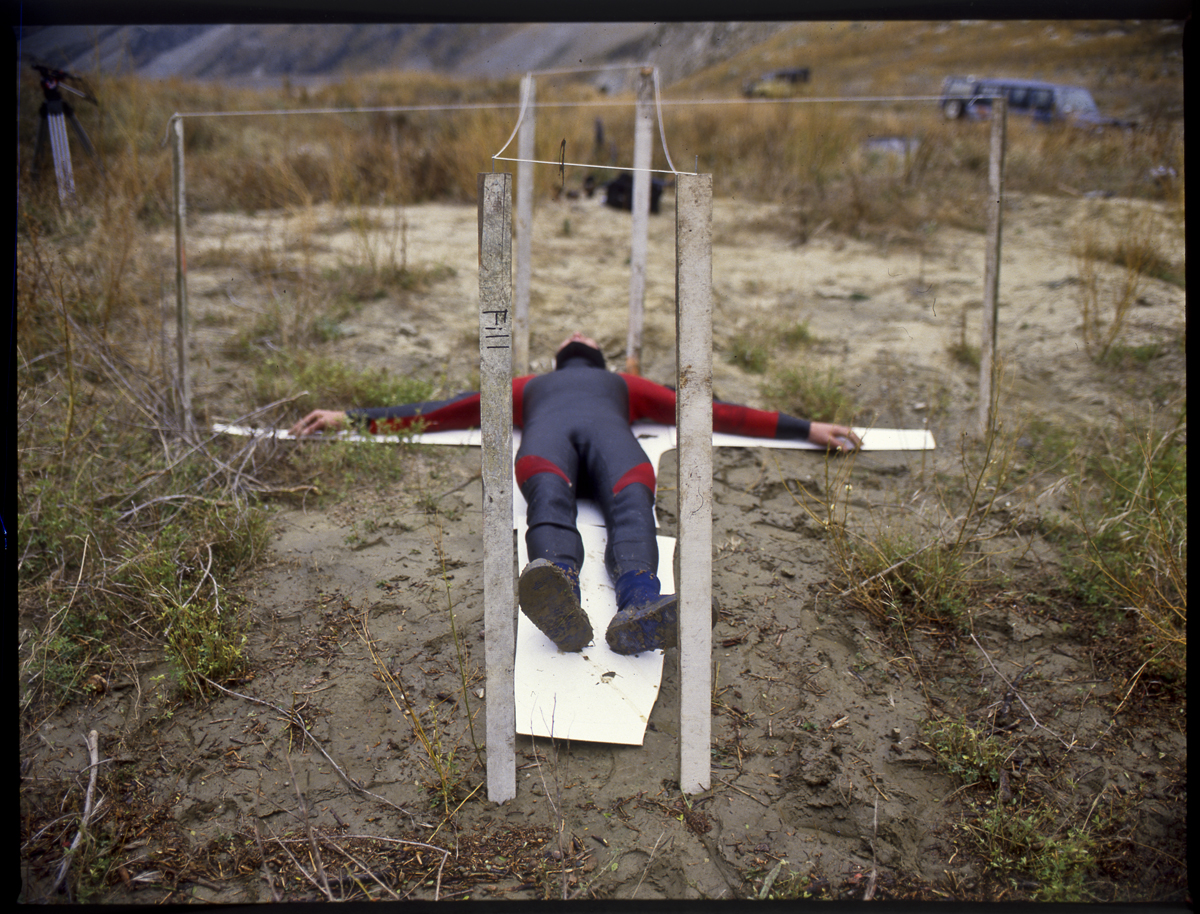 |
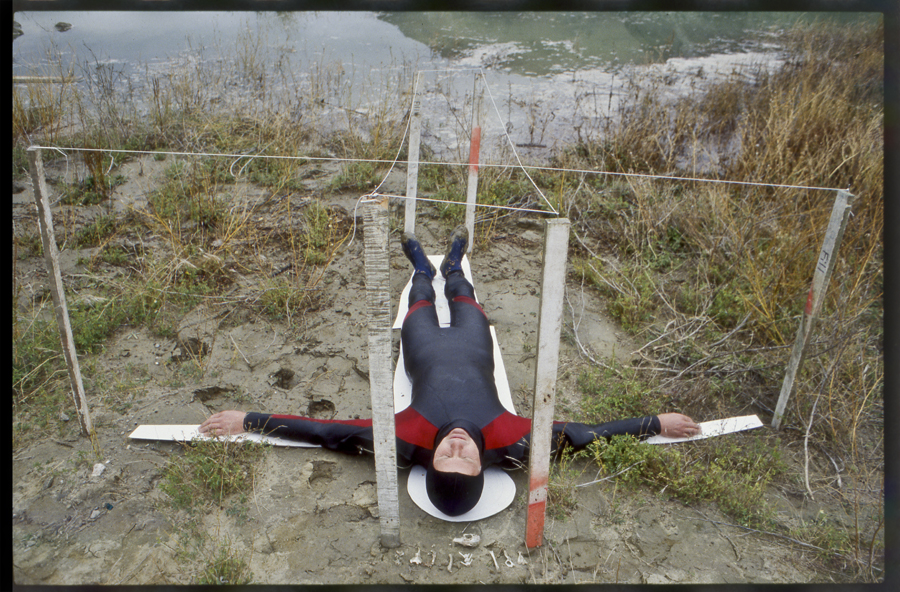 |
Inert, I lay there for possibly
20 minutes, absorbing, synchronizing, my breathing, and heart beating
as that of the earth. At one and as endangered as the condemned land
in the path of this eccentric oncoming force. |
To touch the Earth
a poem from - 1991
( From Drawing from Nature)
I lie on a high
hill, this mound of earth
I feel the sky vaulted above me
Below I sense growth and flux
The stillness vibrates a relaxed silence
I am nowhere and everywhere at once
Recharging, absorbing,
purifying
My heart is synchronised with a larger pulse
The vortex of an earth in space
An unfolding universe, a grain of sand
The intoxication of infinite spin
How am I above this organic growth
yet below its understanding?
I NEED TO RETURN AGAIN. |
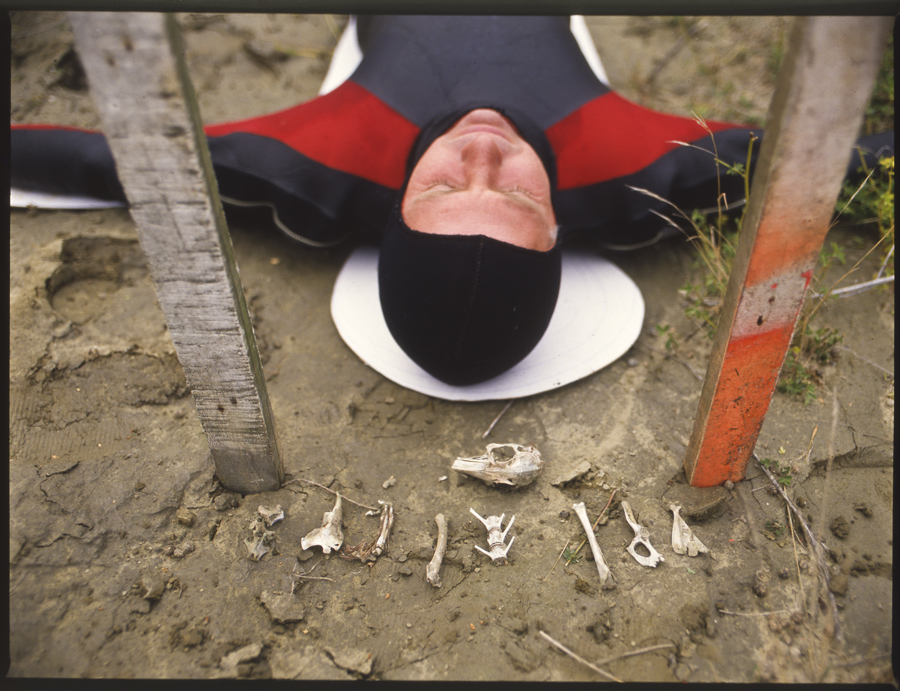 |
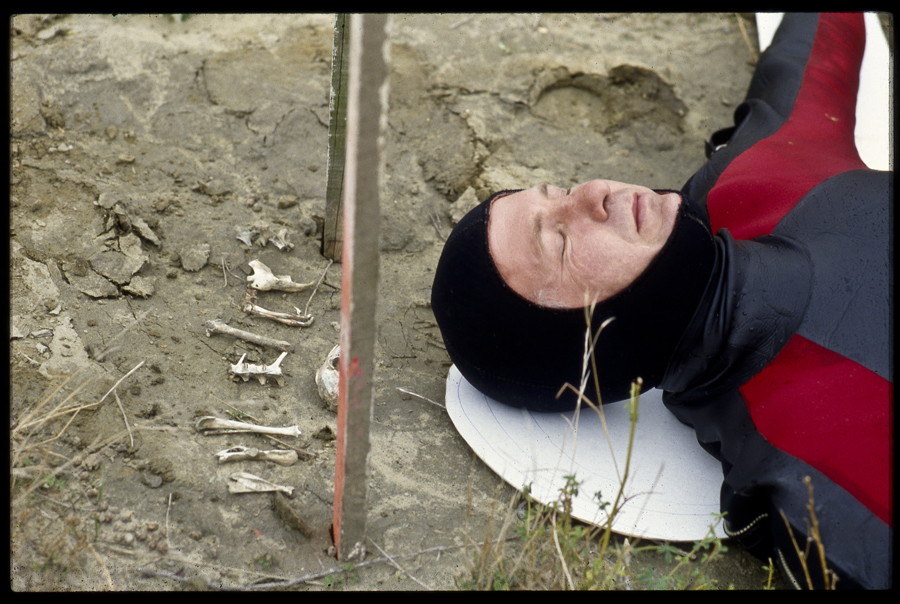 |
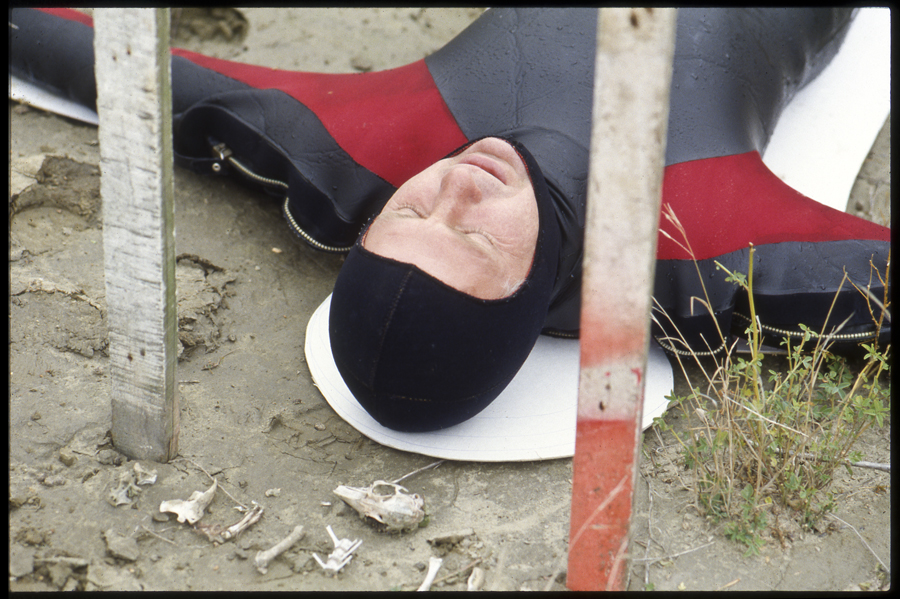 |
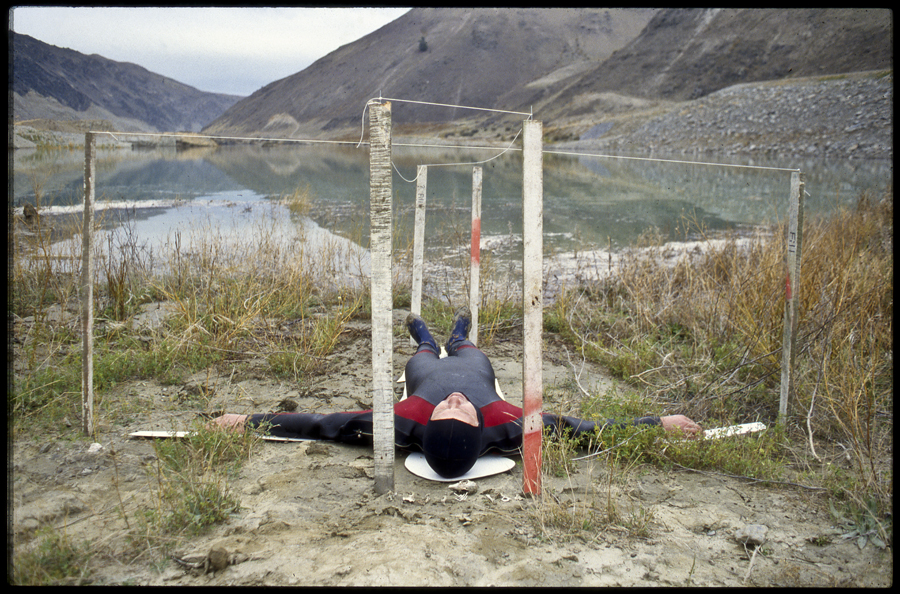 |
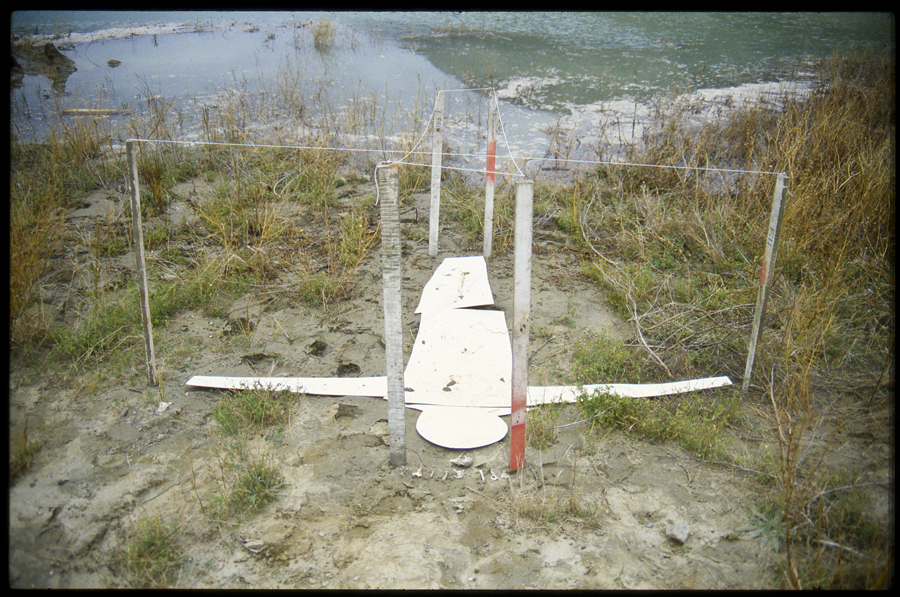 |
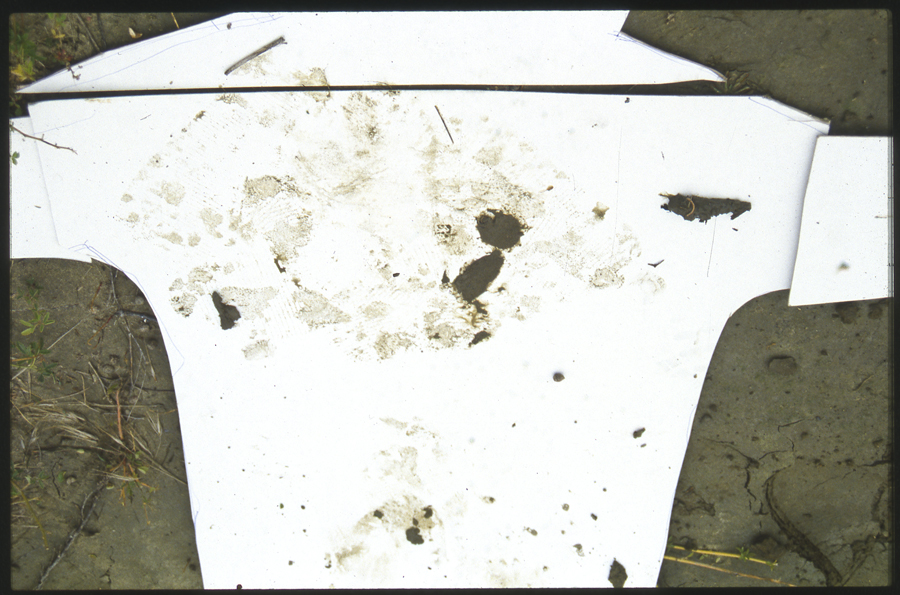 |
Later I rose as from a hibernation,
with an air of melancholy. I walked back down to the lapping water,
checking the new level of this ever-rising tide, then marked this with
another stick. It had risen nearly three inches from the previous
mark in the time I had been the earth. I had recorded the rise and the
time with two simple sticks. More water would soon cover much of the
earth I had always loved and possessed with my eyes and emotion, but
the turbulence of the wild blue river that had roared below here was
already gone!
At the time the television
crew seemed totally perplexed by the work, and they later informed me
that although the work was interesting and relevant they had decided
not to put it to air because it lacked something. But they mentioned
they would be quite keen to re-shoot and thought it would have more
appeal if I was prepared to do it again in the nude; to which I declined. |
Even with the initial filling
of the lake there continued a range of engineering problems that delayed
the continued filling of the dam. Drainage tunnelling and stabilizing
work emerge as an endless task and continued for months and at great
extra expense.
Later in the year, once
the new water level had settled and Electricorp was convinced there
was little threat of subsidence, it planned another raising of the lake
level.
In the interim
I had given much thought about a second performance. Perhaps as delayed
hallucination from an electrical apprenticeship I endured when leaving
school, a response to the dam, or the sensitivity of the earth, I had
dreams, quixotic dreams, where I contemplated the earth and the river
as having its own gigantic "earth" electrical circuit and people as
an indirect extension of that circuit, or complex intricate components
of a whole. I dreamt of strange ceremonial artifacts, conducting rods,
dividers, induction coils, connectors etc artifacts from an invented
mythology religious items from a different power. Soon I engaged in
the making of conductive artifacts from the remains of discarded objects
of brass with past uses from past times. For months before the performance,
I scoured the local scrap merchant's brass bins, selecting potential
parts, laying them out to create new objects. I then fused these unrelated
items into structures that resembled strange religious artifacts.
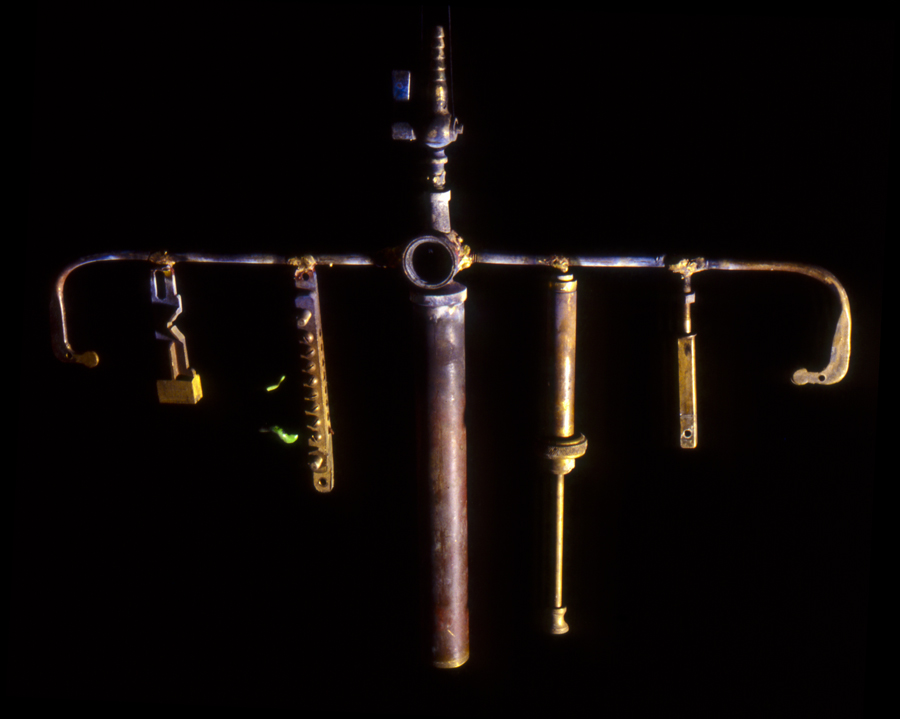 |
Old taps, rods, worn door
knobs, parts of locks and pumps, rings, threaded bolts, long screws,
strange segments from forgotten artifacts with equally forgotten uses,
intricate moldings of their own aesthetic, these became the elements
that were arranged and then braised together to fuse them as new one
"new" singular object, eccentric objects that appeared to have some
ritualistic function. I formed the weekly habit of scouring the scrap
bins, arranging them into curious orders and braising them together;
continually, I forged item after item |
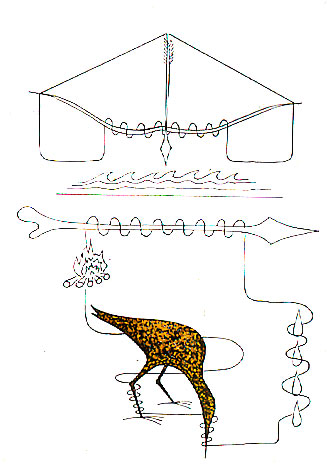 |
. I also work on a series of
"circuit drawings' where I investigated the idea of the circuits further,
where I investigated the "potential difference" between
objects, actions and consequence. Various objects that related
to the project were drawn as line drawings and linked by lines as in
an electrical circuit diagram. The lines would either be connected to
the object (bones, feathers, saws fire, rain clouds etc) or wrap around
it as an induction coil. People were represented and wired into the
circuit by a silver triangular plate representing one hand and a gold
one for the other hand. The drawings investigated the potential of direct
and indirect links between object/environment, cause/effect for the
proposed "earth circuit" second performance. |
Electricorp seemed to have
problem after problem and the date for the next level raising was postponed
and postponed, dates were confirmed and then moved. I had a trip to
Australia due and hoped that the next fill would not take place while
I was a way.
Eventually the next fill
date was announced to take place just two days before I was due to fly
to Australia, so with little notice and the series of ceremonial earth
stakes etc, dry suit and a few friends I scampered off up to the
dam site. This time I made no attempt to contact Electricorp for permission.
PERFORMANCE II Aug 1993 - Lloyd Godman
On arrival the first task
was to find a suitable site, a site with a flattish area sloping away
to the rising water a site that faced up the old dying river. As we drove
up and down the gorge searching for a suitable location, the topography
looked unfamiliar, no river flowed deep in the valley, it seemed strange,
and still does, to see the new lake flooded up the gorge where the river
had run with such power. Where the tributaries had joined the main river,
the junction points were different, the prominent rocky outcrops that projected from the water were all new.
| As with the first work,
the performance was done with a consciousness of myself as an integral
part of the environment, a fidelity and an attention to detail, in an
attempt to introduce a physical poetry to the event. After some searching,
I had found a suitable area for the performance. Although a little slanting
at the top, it ran down to the river from a great rock by the road side
and had a series of corrugations where it had recently been flattened
out by a bull dozer. It took some time to lay out all the "ceremonial
artifacts"; wire, clips, underwater camera housing etc. As in the first performance, I
dressed in the black insulation of a rubber dry suit and with slow deliberated
movements began to install the various components. First was the camera
itself which had to be positioned facing up the lake and to an exact
depth in the water so that the lens was giving an angle of view just
above the current water line. It also had to be held fast with a pile of large
rocks as any movement of the housing would ruin the framing for the
sequence of photographs. |
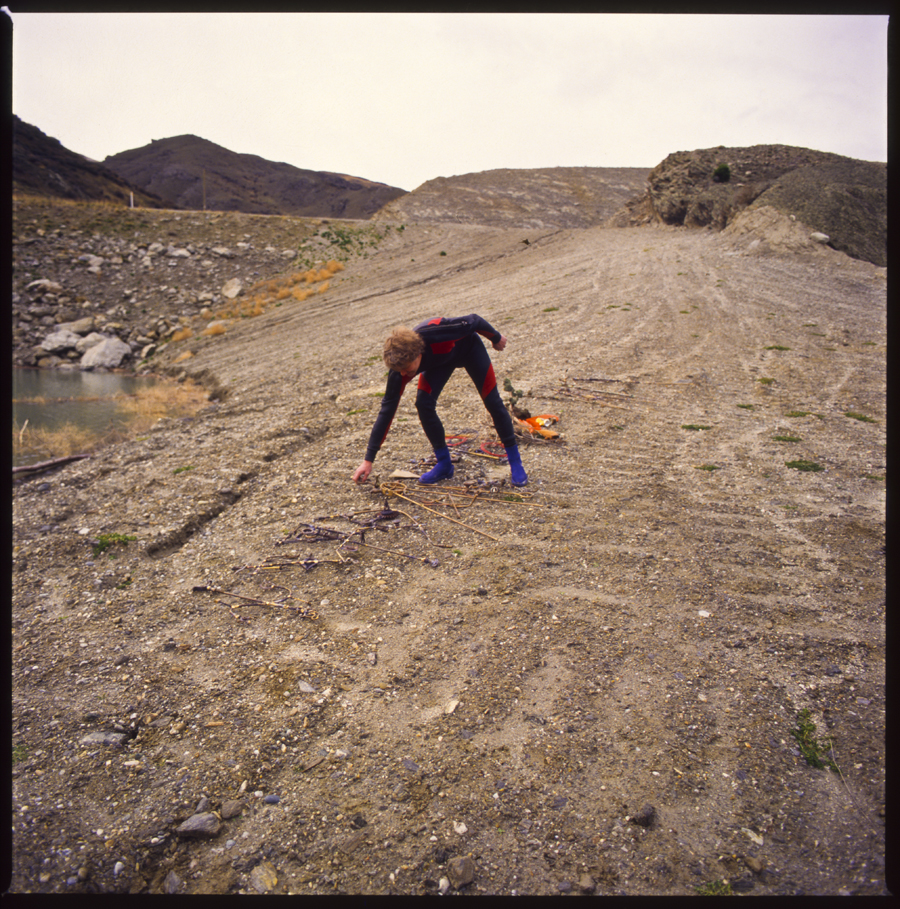 |
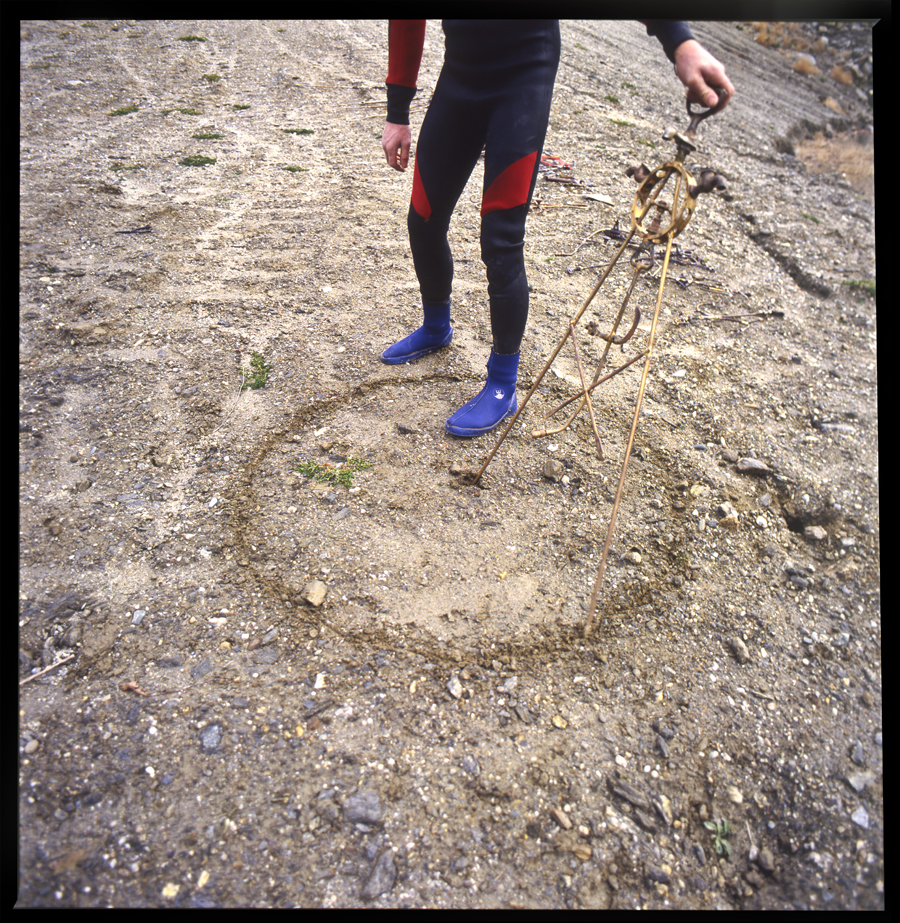 |
I ran a cable from the motor
drive of the camera though the housing up to the graveled beach.The conductive Artifact X male dividers were selected and I found a location to scribe a circle in the gravel, with there was a metalic sound as the instrument cut a line into the fine aluvial gravel and intermtantly connected with larger rocks. |
Next I selected the other dividers, conductive Artifact X Female dividers and again scribed a circle into the earth. |
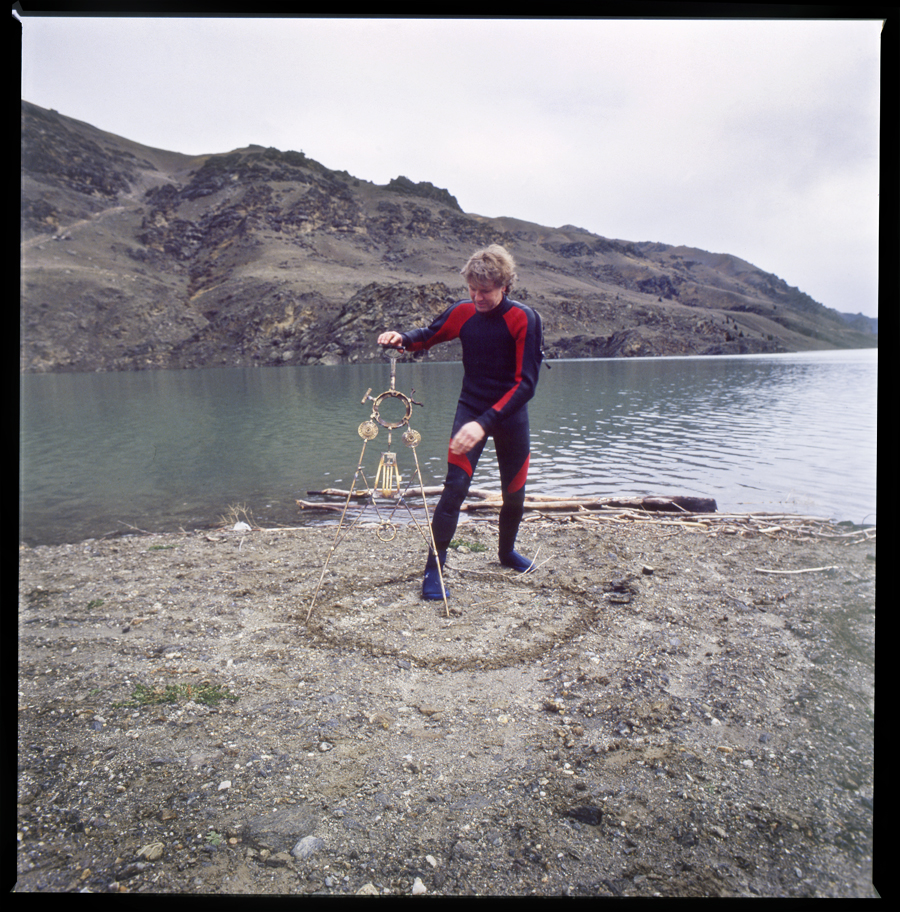 |
 |
Both pair of dividers were driven into the gravel at the waters edge and supported with large rocks so as they stood upright in contrast to the water. |
| At the centre of each circle an earth rod was drived upright into the gravel conductive Artifact XII Earth Rod |
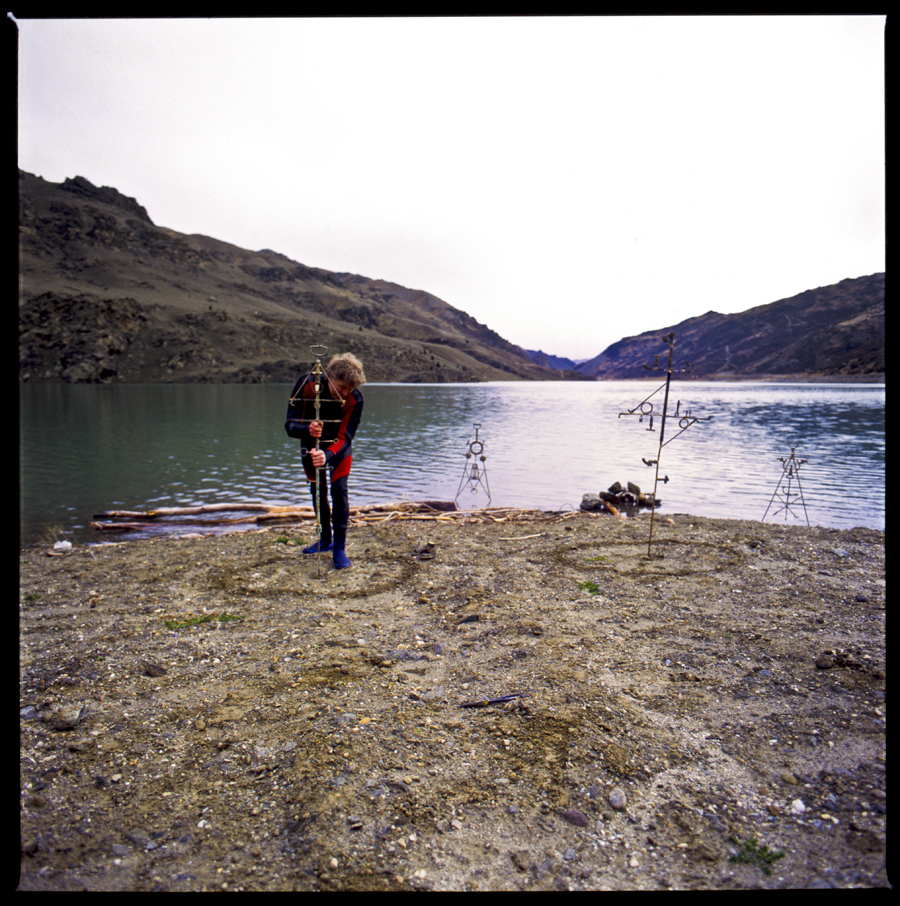 |
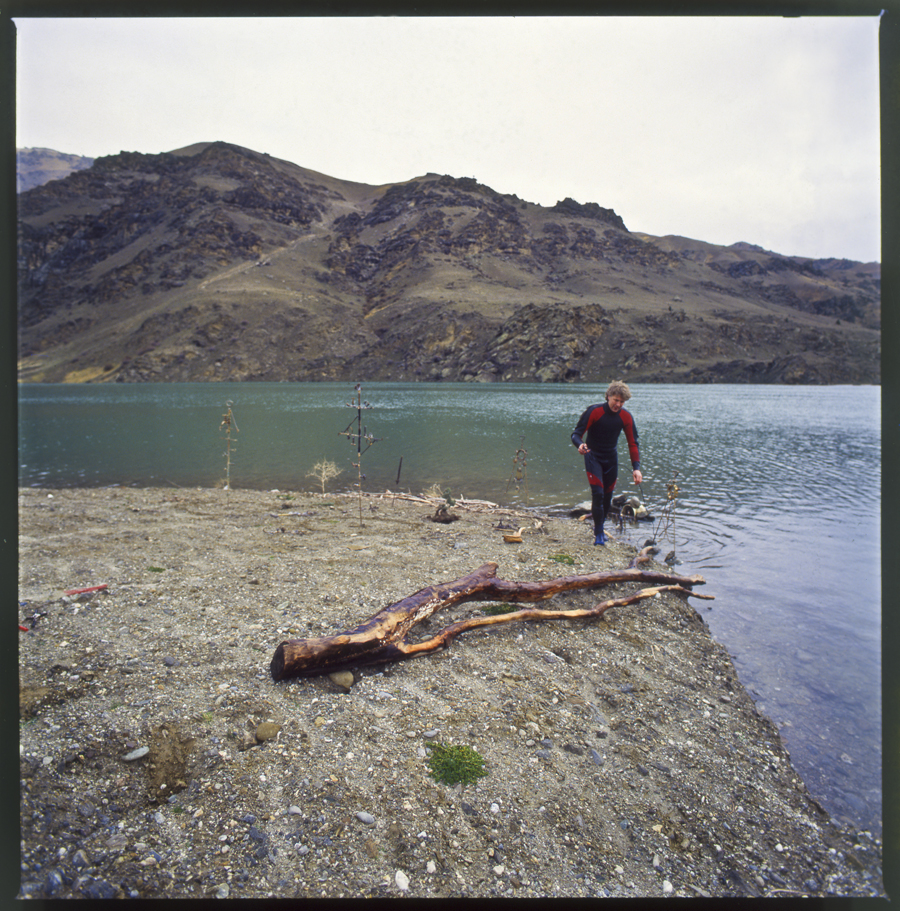 |
A large log floating in the water was moved up the shore and positioned with its branches reaching out towards the advancing water. |
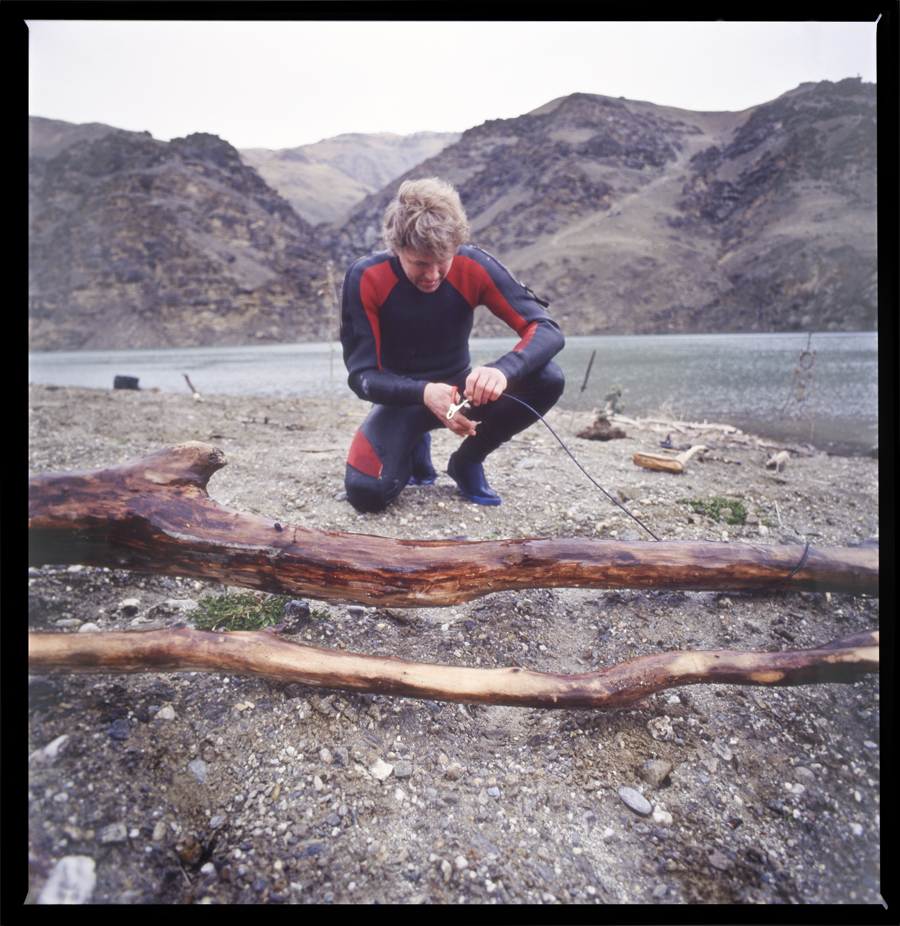 |
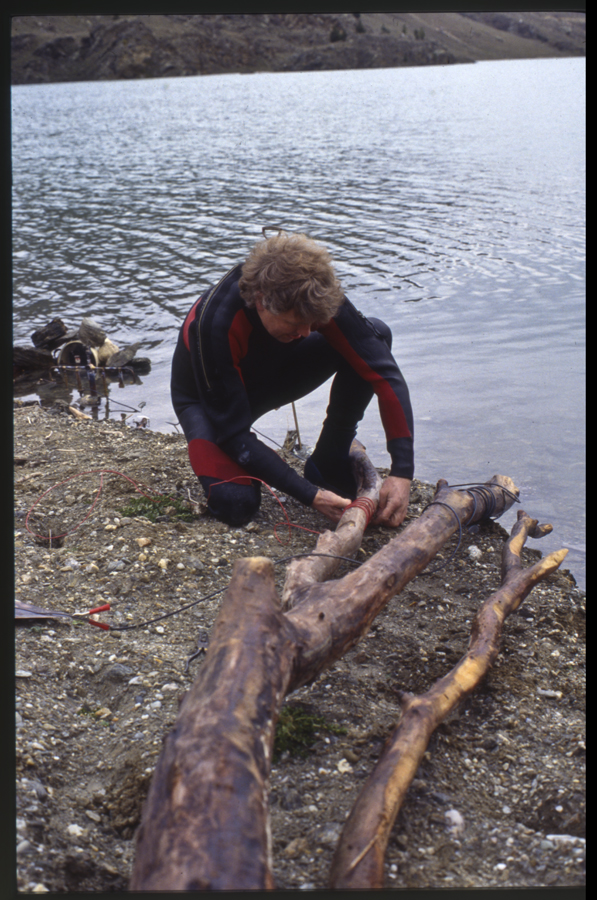 |
One
side of the circuit continued on from here and was connected to another
long length of wire which was wound as a series of metaphorical induction
coils around a range of organic objects found lying on the site: a branch,
some discarded feathers, a fern frond from a plant growing near-by,
a small thyme bush somehow ripped from the ground and now lying roots
exposed, bones, a large tree branch etc. Interspersed in the circuit
with the organic items were the "ceremonial artifacts" I had spent time
making in the weeks leading up to the performance - earth rods, dividers,
strange objects, which had earlier been used to scribe circles on the
beach. Appropriate "artifacts" were rammed into the soil, some in the
water, some on land, others were simply laid out on the gravel.
After the linking of these
objects, this side of the circuit ended clipped to a triangular brass
plate. My arms-width apart, I placed a similar copper plate and from
here the second part of the circuit ran directly back to the return
wire from the camera motor drive. The installation of this circuitry
was performed in slow methodical movements. Once the "Earth Circuit"
was in place I lay on the ground
arms out stretched to form a cruciform as in the first performance.
My hands were placed on the ground just below the metal plates, and
at interspersed intervals over several hours I would touch the two metal
plates which would fire the motor drive and record the increase of the
rise of the lake level. (When dressing, I had earlier placed a wire
in the black rubber dry suit from hand to hand across my shoulders,
and the symbolic connection was made through this wire).
However casual or premeditated
the act may be, the taking of photographs is a ritual. The scene is
selected, the framing adjusted, a light meter reading taken, the aperture
and shutter settings arranged, the lens focused and perhaps the procedure
checked before the shutter is tripped. The unacknowledged ritual takes
place thousands of times a day where the thought and emphasis is on
the image not the act. The ritual of making is generally forgotten,
the physical act happens on a subconscious level. Assimilating the photo-taking
act into the performance, where the process is linked directly to the
artifact, is quite distinct from taking photographs of someone during
a performance. As in the first performance, I incorporated this photographic
ritual as part of the work, and the final sequence of photographs are
a consequence of the work, not a document of the performance. While
the traditional ritual of taking photographs was combined with the ritual
associated with the constructed artifacts, the act was also removed
by placing the camera in the water and taking the images at random intervals
from a dislocated position.
Aug 1993
By the end of the second performance I had taken a second series of
photographs where the lake level had risen and obscured the previous
view up the lake. I deliberately left no distinct end to the performance
and our leaving, as I wanted there to remain a degree of indeterminacy,
the potential of a continuum.
end
Technical information for the Last rivers
Song - Project 1983-4
Cameras
Nikon F2 - used for land based shots
Nikon EM with power winder - used for shots from the boom suspended above the water
Linhof 4x5 Cardan Colour - used to copy prints onto 4 x5 film for the mural enlargements
Lenses:
20mm f3.8 Vivitar
50mm f1.8 Nikon series E
55mm f1.2 Nikkor SC
135mm f2.8 Nikkor Q
150mm f f.6 Symmar
Filters
K2 Yellow
YA2 Orange
25A Red
Neutral Density x2, x4, x8
Exposures : From 2min @f22 to 1/2000 @ f5.6
Films:
Pan F, FP4, HP5, Tech Pan
ASA Ratings:
3asa to 1800asa
Developers:
Michrophen, ID11, Perceptol, P.Q Universal, Tech Pan LC
Photographic paper Kodak Mural
Paper R3
Ilfobrom
Technique
All the photographs were first shot on on 35mm film using a variety of
approaches:
.
Time Exposure
Tech pan film and
Pan F were down rated and exposed through a series of neutral density
filters which allowed exposures of 2minutes at f22 in bright sunlight
with the camera on a tripod in the shallows of the river. The technique
was used for the images in Mural 4 and 5 and in panels 5,7, and threes
prints in panel 9.
Boom
The nikon EM was
suspended with the power winder on a retractable boom set on auto exposure
out and just above the river surface An accurate record of the exposures
was impossible to keep - but would probably range from 1/1000 sec to 1/30
sec. All these exposure were made using an auto exposure setting.
Gold
Toning
The
murals consisted of large composite photographic images up to 6-7metres
long and containing up to 7 prints 5'x 2 1/2'.
Selected
prints from this series were gold toned with native gold dredged from
the Clutha river and donated to the project by Bob Gray. The gold dust
was converted to gold chloride by Bob Cunningham from the Chemistry Dept
at the University of Otago, and combined with other chemicals in such
a manner as to produce either red and deep blue tones in the photographic
prints.
Soundscape
The enigmatic
electronic soundscape that accompanied the exhibition was specifically
composed by Trevor Coleman & Paul Hutchins for the installation in
1984.
Trevor
and Paul played live at the opening in the Dunedin Public Art Gallery.
|